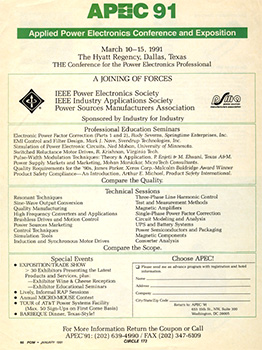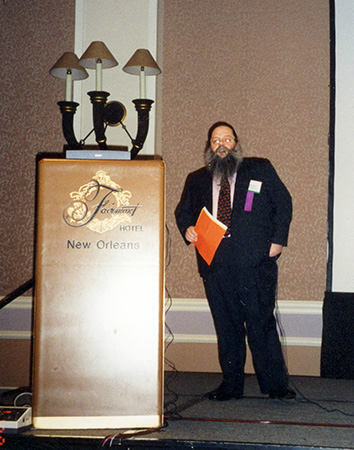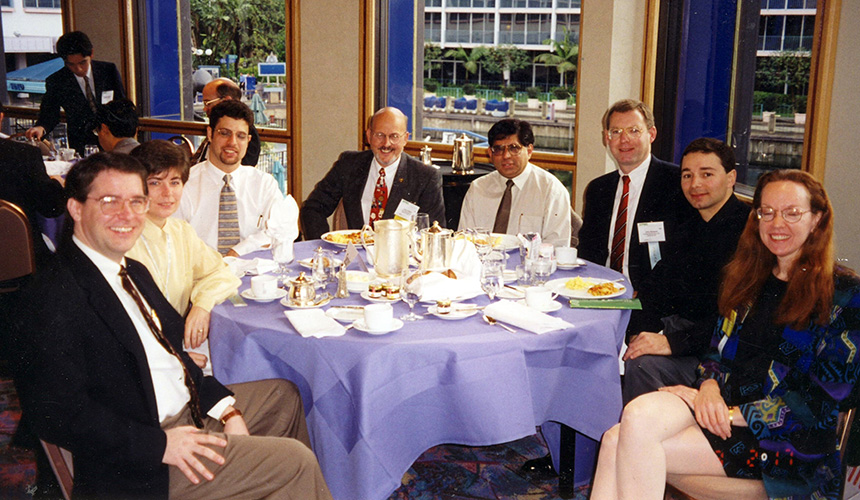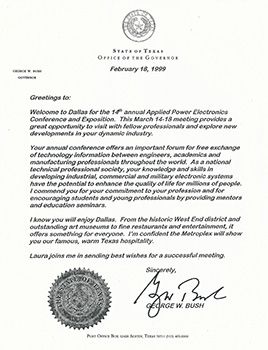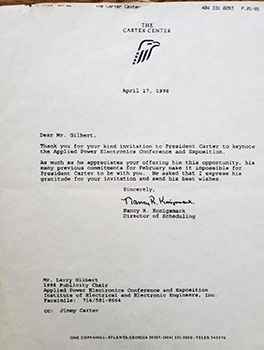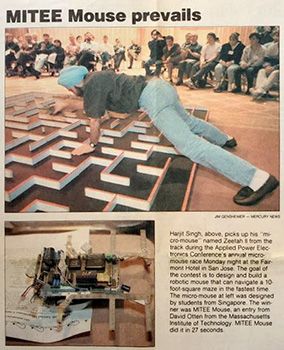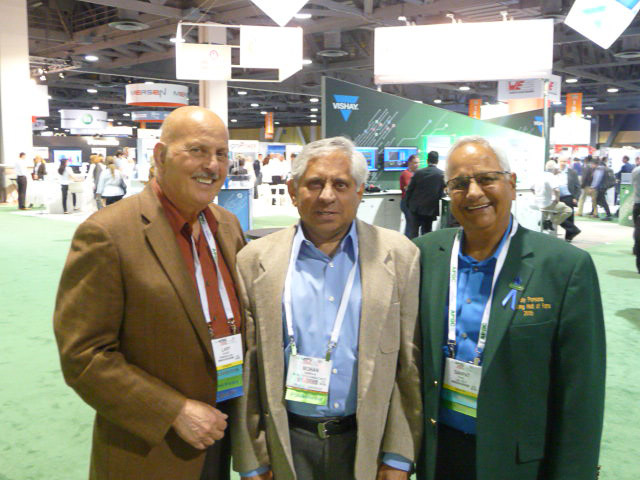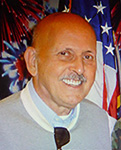The Summer Edition of the EPSMA Newsletter is now available here.
Other news of interest
Twenty years ago, the adoption of the Restriction of Hazardous Substances Directive 2002/95/EC (RoHS 1) was one of the driving forces mandating the electronics industry to look for alternatives to replace the tin-lead eutectic alloy which had been used for decades for soldering purposes. Since then many regulations have sprung up restricting the use of hazardous substances, and we are familiar with RoHS, REACH, TSCA and others. In addition, growing concerns about long term sustainability and optimization of natural resources have motivated governments, institutions and industry to consider how to develop a circular business model, including elements from the cradle-to-cradle concept, and to define an optimum way to trace a product from its origin, its content, its compliance to environmental regulations, its reparability or final disposal and recycling. This materialized in March 2022 by the European Commission as part of the EU Green Deal, and was followed by similar initiatives in the US. But what is it about?!
Here comes the Digital Product Passport
After 10 years of local initiatives, the European Commission presented a package of proposals as part of the European Green Deal to make sustainable products the norm in the EU, moving away from the conventional linear economy by boosting circular business models and empowering consumers for the green transition (Figure 01), including the so called Digital Product Passport (DPP).
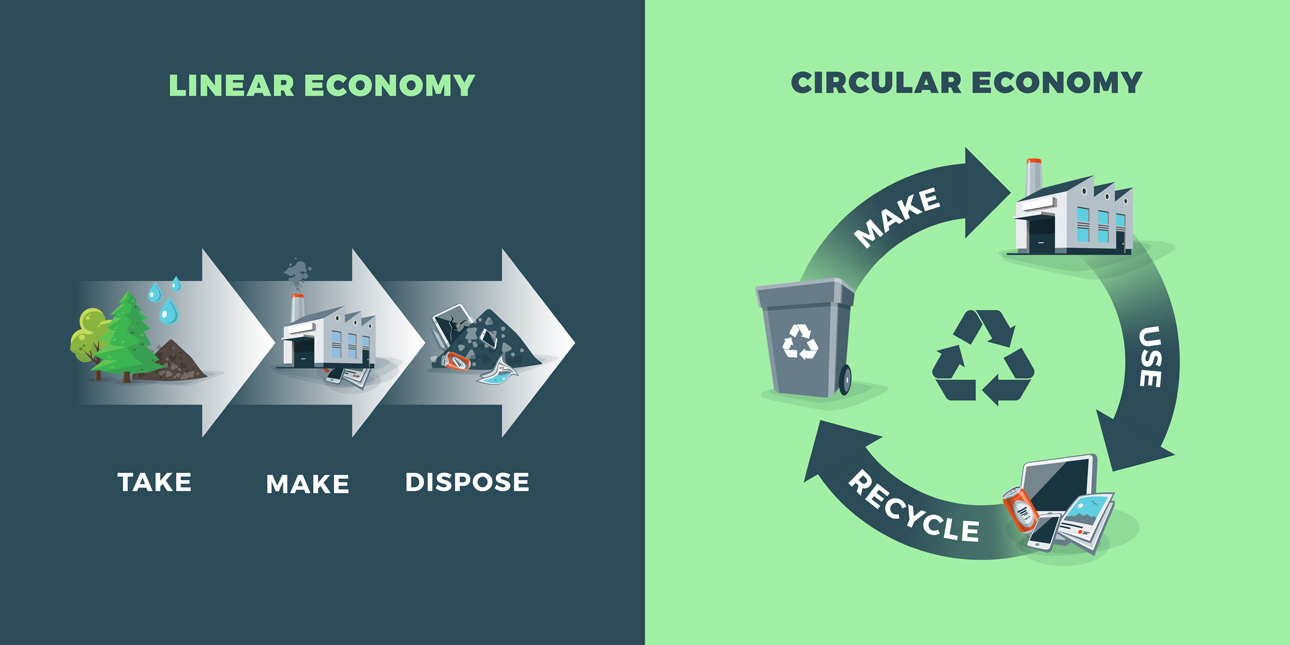 Figure 01 - European Union moving from conventional linear economy to circular business model (PRBX/ petovarga/Shutterstock) Figure 01 - European Union moving from conventional linear economy to circular business model (PRBX/ petovarga/Shutterstock) |
At this point you may question what this has to do with power electronics and how the power supply community may be affected by this new requirement? Where is the threshold between a Point-of-Load, a multi kilowatts power supply or even an Electrical Vehicle? Which power electronics segment will have to comply with the DPP? Read on to better understand and debug what is DPP.
Having the whole life cycle in mind!
The proposal for a Regulation on Ecodesign for Sustainable Products addresses product design, which determines up to 80% of a product's lifecycle environmental impact. It sets new requirements to make products more durable, reliable, reusable, upgradable, reparable, easier to maintain, refurbish and recycle, and energy and resource efficient. In addition, product-specific information requirements will ensure that consumers are knowledgeable on the environmental impact of their purchases.
All regulated products will have Digital Product Passports making it easier to repair or recycle them and to facilitate the tracking of substances of concern along the supply chain. The aim of the passport is to provide producers and other key supply chain actors, as well as consumers and market surveillance authorities, with relevant information for ensuring the sustainable management of products. If well designed, and if aligned with existing industry initiatives, these Digital Product Passports could help to promote the circular economy and circular business models. This may sound quite hypothetical and even complex but let's consider a practical example with the booming energy storage segment and batteries.
The battery industry showing the way!
Since 2006 batteries and waste batteries have been regulated within the EU under the Batteries Directive (2006/66/EC). Though driven by electric transport and energy storage the demand for batteries has increased rapidly and is set to increase 14 fold by 2030. Such global exponential growth in the demand for batteries will lead to an equivalent increase in demand for raw materials, hence the need to minimize their environmental impact.
With high levels of concern for the long term sustainability of the battery industry, in 2017 two major initiatives took place in Europe and the USA. Both of these were similarly aimed: to develop an innovative, competitive and sustainable battery value chain in Europe and the USA with high regards for the environment and society.
In Europe on October 11, 2017, the European Commission hosted auto, chemical and engineering executives in Brussels to strengthen battery manufacturing in the EU and to develop a European ecosystem to reduce dependency and risk in the supply chain of what will become the heart of energy transition and mass electrification. This was followed by the launch of the European Battery Alliance (EBA) as part of Europe's clean and digital transition and a key enabling technology, essential to the automotive sector's competitiveness.
In the USA, in the same year, a public-private collaboration platform was founded at the World Economic Forum to help establish a sustainable battery value chain by 2030, The Global Battery Alliance (GBA).
It can be said that 2017 has been the EU/USA cornerstone for the battery industry setting the basic principles of what will become the DPP and a completely new way of working, integrating the full life-cycle for all batteries (i.e. industrial, automotive, electric vehicle and portable) in the EU and US markets.
Within the whole chain, industrial suppliers will take responsibility for sourced materials, with restricted use of hazardous substances, minimum required content of recycled materials, carbon footprint, performance and durability and labeling, as well as meeting collection and recycling/reuse targets. The overall process is very complex and both alliances have developed a standardized process, of which the Digital Product Passport is the ultimate representation.
From concept to practice
As we move forwards, the Digital Product Passport has started to become a reality and, as presented in March 2022 by the EU Commission as part of its Circular Economy Action Plan 'Ecodesign for Sustainable Product Regulation' (ESPR), the DPP will cover all stages of the value chain; it will be continuously updated and will follow the product throughout its life cycle (Figure 02). Also worth mentioning, the EU Commission and the U.S. Department of Energy (DOE) have announced support for a collaboration between the European Battery Alliance and the United States. The Li-Bridge alliance is commited to accelerating the development of robust supply chains for lithium-ion and next generation batteries, including the critical raw materials segments. Bolstering the clean energy economy and strengthening the battery value chain is a top priority for both the European Union and the United States.
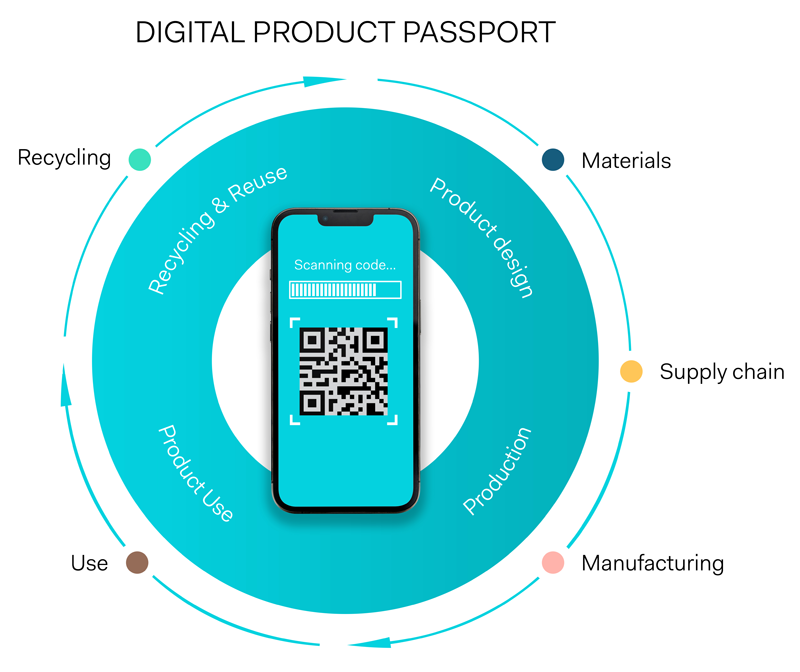 Figure 02 - Digital Product Passport in circular economy (PRBX/ Dejan Popovic/Shutterstock) Figure 02 - Digital Product Passport in circular economy (PRBX/ Dejan Popovic/Shutterstock) |
Europe on April 25 2022, a consortium of German world-class leaders and market drivers from industry and science combined their forces, launching the Battery Pass to support EU circular battery data. A technological feature of the project is the provision of a comprehensive solution for securely sharing information and data across different organizations and value-chain participants in the field of traction batteries, based on mandatory standard datasets and an interoperable technical implementation approach required to meet the EU regulation.
In the United States in October 2022, the Global Battery Alliance announced a major milestone with the publication of the Greenhouse Gas rulebook as the first indicator for the Battery Passport, consisting of:
- A global reporting framework to govern rules around measurement, auditing, and reporting of ESG parameters across the battery value chain.
- A digital ID for batteries containing data and descriptions about the ESG performance, manufacturing history, and provenance as well as advancing battery life extension and enabling recycling.
- Harmonizing of digital systems collaborating across the value chain to report data into the battery passport.
- A digital platform that will collect, exchange, collate and report data among all authorized lifecycle stakeholders to advance a sustainable value chain for electric vehicle (EV) and stationary batteries. It will transparently report progress towards global goals along the battery value chain to inform policy-making for governments, the civil society, and to develop performance benchmarks (Figure 03).
- A quality seal for batteries (based on the data reported into the platform) to facilitate responsible purchasing by consumers.
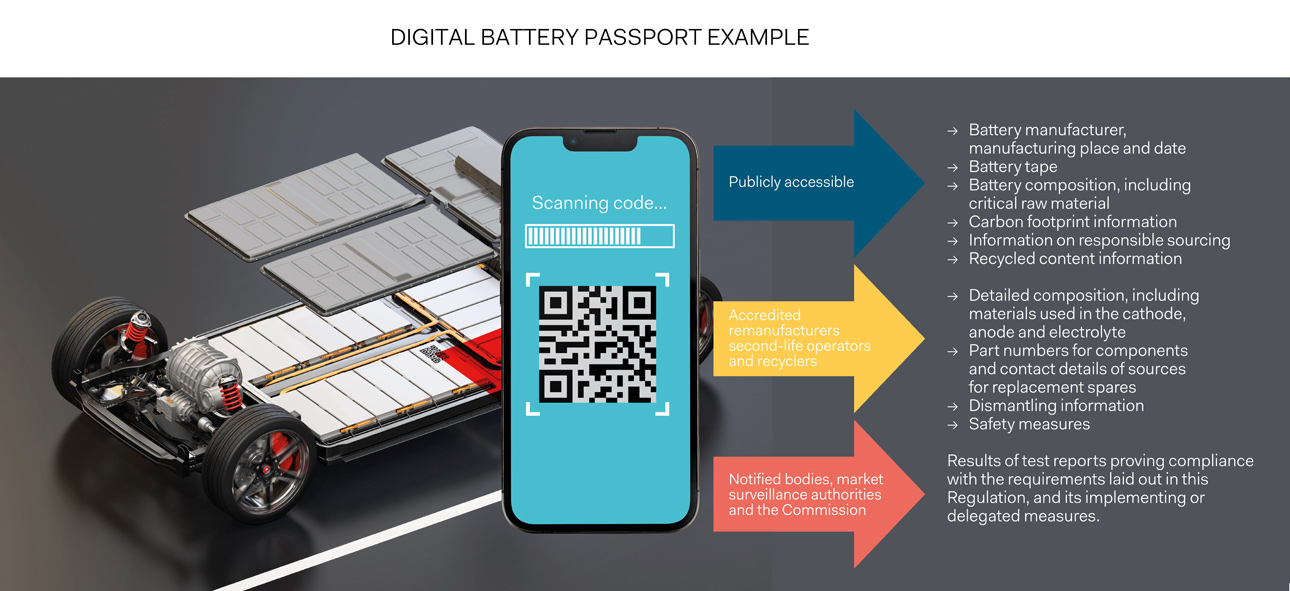 Figure 03 - Battery Digital Passport Example (PRBX/Chesky/Shutterstock) Figure 03 - Battery Digital Passport Example (PRBX/Chesky/Shutterstock) |
Those examples reflect the high engagement from the battery industry to finalize the implementation of the DPP, which will be used as a business model for other power electronics industries.
What is the next step for DDP and power electronics?
As for the battery industry, in 2017 Powerbox participated in a Think Tank about the future evolution of the power supply industry to reduce waste and to become part of a project at that time, the Regulation on Ecodesign for Sustainable Products. In a White Paper: 'Will the power supply industry adopt the cradle-to-cradle business model?' PRBX shared ideas on what could become the norm (Figure 04).
 Figure 04: Will the power supply industry adopt the cradle-to-cradle business model (PRBX) Figure 04: Will the power supply industry adopt the cradle-to-cradle business model (PRBX) |
Although we are probably a few years away from the power supply industry adopting the DPP, this trend is something to be aware of and to keep in mind and it could happen faster than we may believe. Be ready for it!
References:
Powerbox (PRBX):
https://www.prbx.com/
EU Green Deal: New proposals to make sustainable products the norm and boost Europe's resource independence
https://ec.europa.eu/commission/presscorner/ detail/en/IP_22_2013
The Ecosystem Digital Product Passport (CIRPASS)
https://www.digitaleurope.org/digital-product-passport/
European Battery Alliance
https://www.eba250.com/
The EU Battery Pass
https://thebatterypass.eu/
The USA Global Battery Alliance
https://www.globalbattery.org/
LI-Bridge
https://www.anl.gov/li-bridge
Will the power supply industry adopt the cradle-to-cradle business model?
https://www.prbx.com/literature/white-papers/#WP012
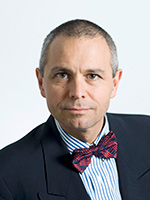
Provided by Patrick Le Fèvre
Chief Marketing and Communications Officer, Powerbox

AdaClock provides strategic technical marketing which includes:
Insights for Power Management
- Identify company & product strengths and weaknesses
- Market & product trends and analysis
- Identify market disruptions & new markets/customers
- Market entry strategies
- Competitive intelligence
- Strategies for defending current markets
- Specific analytical insights into the Power Supply in a Package (PSiP) & Power Supply on a Chip (PwrSoC) market
Results Oriented
- Defining products that stand out from the competition and command high margins
- Anticipate customers' expectations.
- Identify potential partners, advocates & acquisition targets to strengthen market position.
Benefits of using AdaClock
- Technical marketing expertise without overhead.
- Objective perspective from the outside.
- Ability to talk with customers & competitors without association to your company.
- Scalable resources depending on scope and timing.
Provided by Ada Cheng, Marketing Consultant, AdaClock.
Hong Kong Applied Science and Technology Research Institute (ASTRI) was founded by the Government of the Hong Kong Special Administrative Region in 2000 with the mission of enhancing Hong Kong's competitiveness through applied research. ASTRI's core R&D competence in various areas is grouped under four Technology Divisions: Trust and AI Technologies; Communications Technologies; IoT Sensing and AI Technologies and Integrated Circuits and Systems. It is applied across six core areas which are Smart City, Financial Technologies, Re-Industrialization and Intelligent Manufacturing, Digital Health, Application Specific Integrated Circuits and Metaverse.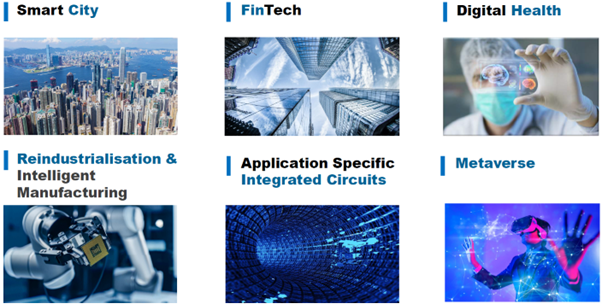
Over the years, ASTRI has nurtured a pool of research, I&T talents and received numerous international awards for its pioneering innovations as well as outstanding business and community contributions. As of 2021/22, ASTRI has transferred almost 1,250 technologies to the industry and has been granted over 1,000 patents in the Mainland, the US, and other countries.
What We Offer
As a Hong Kong R&D Centre, one of ASTRI's important goals is to help customers harness business opportunities from the thriving technology market and increase their competitive strengths. Customers and partners can improve their efficacy by drawing on ASTRI's expertise and research achievements.
- Technology Transfers
ASTRI has a rich portfolio of commercially viable technologies readily available for market deployment. There were close to 1,250 cases of technology transfers conducted through research contract, technology licensing and other forms of partnership, generated a total of over HK$450 million income received from industry.
- R&D Professionals
ASTRI has teams of brilliant researchers led by competent professionals, many of whom are prominent technologists in their respective fields. ASTRI has 600 staff, with 23% holding PhD degrees and more than 56% holding Master's degrees.
- Intellectual Properties
ASTRI has produced a volume of home-grown and patent-protected technologies. Since its establishment, the institute has filed more than 1,300 patents and more than 1,000 of which have already been granted in US, China and worldwide.
Provided by Dr. Ziyang GAO, Associate Senior Director of Integrated Circuits and Systems, ASTRI
Four members of the Board of Directors are elected at the PSMA Annual Meeting held every year, usually held during the APEC conference. Each Director serves a three-year term and is eligible to be reelected for one additional term.
In this issue we would like to introduce you to Brian Zahnstecher who will complete his second term at the 2023 PSMA Annual Meeting.
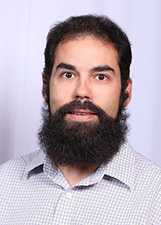
Brian Zahnstecher
Principal, PowerRox
Brian Zahnstecher sits on the Power Sources Manufacturers Association (PSMA) Board of Directors, is Co-founder & Chair (Emeritus) of the PSMA Reliability Committee, Co-chair of the PSMA Energy Harvesting Committee, Co-founder & Co-chair of the EnerHarv workshop. Brian is a Sr. Member of the IEEE, Chair (Emeritus) of the IEEE SFBAC Power Electronics Society (PELS), IEEE PELS North America Regional (R1-3) Chair, and is the Principal of PowerRox. He Co-chairs the IEEE Future Directions (formerly 5G) Initiative webinar series and is the founding Co-chair of the IEEE 5G Roadmap Energy Efficiency Working Group and has lectured on this topic at major industry conferences.
Brian previously held positions in power electronics with industry leaders Emerson Network Power (now Advanced Energy), Cisco, and Hewlett-Packard. He has been a regular contributor to the industry as an invited keynote speaker, author, workshop participant, session host, roundtable moderator, and volunteer. He has nearly 20 years of industry experience and holds Master and Bachelor degrees from Worcester Polytechnic Institute.
Provided by Brian Zahnstecher, Principal, PowerRox
Building on the succ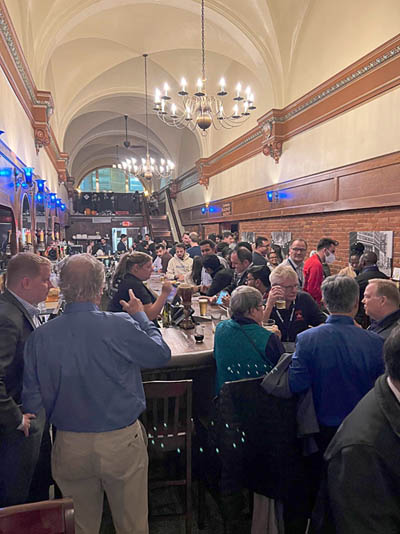 ess of participation in the Young Professionals (YP) social event and Women in Engineering (WiE) roundtable breakfast at this year's Applied Power Electronics Conference (APEC) in March of 2022, PSMA continued efforts to increase engagement by participating in both events during the 2022 Energy Conversion Congress & Expo (ECCE) held October 9-13 in Detroit, MI. Aside from contributing participants and messaging to support event objectives, PSMA provided financial support as a full co-sponsor as part of a concerted outreach effort to promote diversity, inclusion, and early development in the industry.
ess of participation in the Young Professionals (YP) social event and Women in Engineering (WiE) roundtable breakfast at this year's Applied Power Electronics Conference (APEC) in March of 2022, PSMA continued efforts to increase engagement by participating in both events during the 2022 Energy Conversion Congress & Expo (ECCE) held October 9-13 in Detroit, MI. Aside from contributing participants and messaging to support event objectives, PSMA provided financial support as a full co-sponsor as part of a concerted outreach effort to promote diversity, inclusion, and early development in the industry.
The YP social event was held the evening of Tuesday, October 11, 2022, at the Grand Truck Pub not far from Huntington Place Convention Center, where ECCE was held. The event was co-sponsored by the IEEE Power Electronics Society (PELS) YP group and the IEEE Industry Applications Society (IAS) along with PSMA. As the photo shows, this was a standing-room-only event with lively discussions amongst the leaders in both academia and industry with many students and young professionals. Whether the young people were from the North America, Europe, Asia, Africa, or otherwise, the most interest seemed to be in seeking meaningful internships and/or interaction with industry professionals in a target area of focus.
The following morning, Wednesday, October 12, 20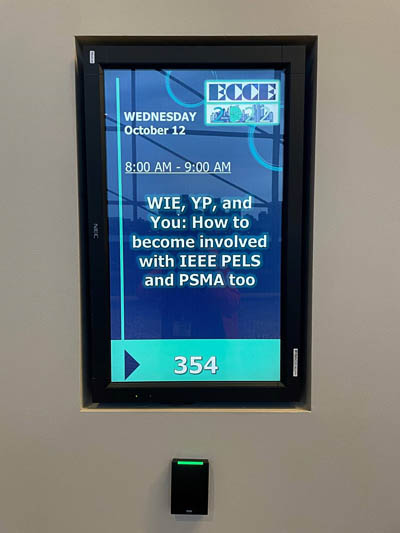 22, started bright and early with the WiE Roundtable Breakfast held n the main hallway of the Huntington Place Convention Center. Unlike the free-for-all format of the previous evening's social event, this event was more structured with many tables each representing a different area of focus that were led by table leaders and mentors from the respective area. PSMA was represented by Greg Evans & Stephanie Watts-Butler supported the event. Several attendees coming to the PSMA table were not previously familiar with the organization and expressed gratitude for having this industry-focused component as part of the overall ECCE program to enhance their industry involvement, and hopefully help to accelerate their own careers. The participants also seemed interested to learn more about getting involved in PSMA activities and programs and were interested in learning more about APEC and other PSMA-sponsored/organized events.
22, started bright and early with the WiE Roundtable Breakfast held n the main hallway of the Huntington Place Convention Center. Unlike the free-for-all format of the previous evening's social event, this event was more structured with many tables each representing a different area of focus that were led by table leaders and mentors from the respective area. PSMA was represented by Greg Evans & Stephanie Watts-Butler supported the event. Several attendees coming to the PSMA table were not previously familiar with the organization and expressed gratitude for having this industry-focused component as part of the overall ECCE program to enhance their industry involvement, and hopefully help to accelerate their own careers. The participants also seemed interested to learn more about getting involved in PSMA activities and programs and were interested in learning more about APEC and other PSMA-sponsored/organized events.
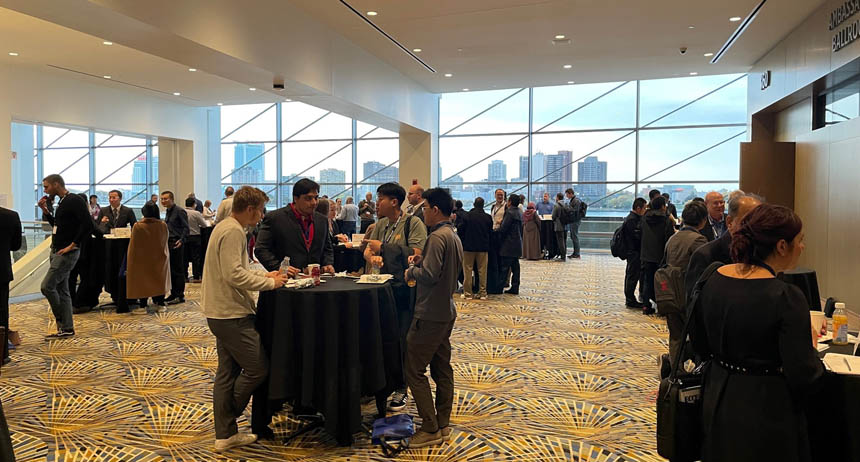
In summary, this was PSMA's initial foray into the world of ECCE and it helped meet the key objectives of increased engaging with the next generation of power professionals. These outreach efforts made many aware of the numerous resources and programs provided be PSMA, and its vast, industry membership base. This was also a chance for PSMA to expand our engagement beyond the traditional focus of APEC and other PSMA sponsored events. ECCE has a far more academic audience than APEC, and the extra injection of industrial support and mentoring seemed to be well-received and even an unexpected boon to some. Hopefully, 2022 becomes the first of many years of events co-sponsored by PSMA and IEEE societies at key conferences (i.e. APEC & ECCE) providing opportunities for deeper engagement and collaboration between PSMA, its membership and most importantly, the pipeline of students and YPs that will eventually be running all these activities in the future.
Provided by Brian Zahnstecher, PSMA Industry-Education Committee Member
KPIs-Metrics that Matter
Building on the foundational work that Trifon Liakopoulos began during his tenure as PSMA Vice President, I have taken the role within the Executive Committee to continue to focus on identifying the KPIs – Key Performance Indicators – that are actionable and will help to improve the performance and effectiveness of the organization. Some of the areas we have begun to measure related to membership are the annual growth rate, member retention rates, and market share of members compared to the number of potential member organizations in the industry. As an organization it is crucial that we continue to grow our membership and to provide significant benefit to our existing members to encourage retention. We need a deep understanding of what member companies value from their engagement with PSMA and to continue to invest in those areas.
It is also critical to monitor the impact of the special projects and events offered to our members and the industry at large. We are establishing KPIs to measure the effectiveness of these activities in terms of member interest and usage, new member recruitment, and revenue impact. Since we are a volunteer driven, non-profit organization, we need to spend our revenue and human resources on the activities that provide the most benefit to our audience and the largest return on investment to our organization.
Lastly, we have established baseline metrics related to website traffic and visitor behavior with a goal to improve the effectiveness of the website to raise awareness, provide valuable content, and increase membership. The website is our most public marketing asset, developing measurable KPIs will help to focus our efforts on providing content that is viewed as relevant and vital to our audience.
KPIs will provide actionable feedback on the success of current activities and identify opportunities for improvement. The Executive Committee will rely on the support and efforts of all members to define, measure, and implement actions to improve the effectiveness of our activities and enhance our efforts to attract new members. We encourage all members to provide feedback, thoughts, and new ideas so we can continue to learn and grow as an organization.
Please feel free to contact me or any of the executive team members with your thoughts and inputs. We would love to hear from you!
-Renee Yawger, PSMA Vice President
 The Power Sources Manufacturers Association (PSMA) announces a series of webinars as a lead-up to the next edition of the PSMA Power Technology Roadmap (PTR). The webinar series, organized by the PSMA Power Technology Roadmap Committee, will feature invited experts from different fields to offer a range of technological perspectives. In addition to setting the groundwork and providing input for the next PTR, the webinars will give participants access to expert opinions on technology trends and include a question and answer session at the end of each session.
The Power Sources Manufacturers Association (PSMA) announces a series of webinars as a lead-up to the next edition of the PSMA Power Technology Roadmap (PTR). The webinar series, organized by the PSMA Power Technology Roadmap Committee, will feature invited experts from different fields to offer a range of technological perspectives. In addition to setting the groundwork and providing input for the next PTR, the webinars will give participants access to expert opinions on technology trends and include a question and answer session at the end of each session.
As in previous seasons, the webinar series will include a number of highly regarded industry and academic experts covering a variety of topics covering components, systems, packaging and applications. The series began on July 28 with a presentation by Victor Veliadis of PowerAmerica "SiC Power Technology Status and Barriers to Overcome." A second webinar was held on August 25 presented by Professor Mike Ranjram of Arizona State University "Coupled Electronic and Magnetic Systems for High Performance Power Electronics." Webinars are scheduled for September and beyond covering a wide range of topics including horticultural lighting, the benefits of GaN in BLDC Motor Drives and many other topics.
Webinars are tentatively scheduled to be held every other Thursday from 10:00-11:00 a.m. US Central Time. For updates to the schedule and news of webinars that will be added, please visit: www.psma.com/technical-forums/roadmap/news-events and follow us on LinkedIn and Twitter. To join the PSMA mailing list to receive invitations to all upcoming webinars, sign up at www.psma.com/webforms/psma-email PSMA gratefully acknowledges the generous support provided to the 2021-22 PTR series by the following underwriters: Gold - RECOM Power GmbH; Silver - Applied Materials, Infineon, Wolfspeed, Würth Elektronik. If your company is interested in underwriting the webinars in 2023, please contact the PSMA Office at power@psma.com.
The Power Technology Roadmap provides a consolidated outlook of trends in power conversion technology for the next two to five years. The trends provided in the report are intended to give a broad outlook of the power conversion technologies, components and applications. The complete Roadmap document has been published every two or three years, incorporating the content of the Roadmap Webinars Series conducted over the months prior to publication. The other content for the report is sourced from a wide range of recognized industry experts and comprises write-ups about trends in components, applications, emerging technologies and university research. It also includes a comprehensive projection of key metrics evolution in four selected power conversion technologies (ac-dc front-end power supplies, ac-dc external power supplies, isolated dc-dc converters and non-isolated dc-dc converters).
Conor Quinn of Advanced Energy and Dhaval Dalal of ACP Technologies, Power Technology Roadmap Committee Co-chairs, stated; "The PTR webinars provide a window into technology trends and the presentations are unique in terms of their diversity of perspectives, commercial-free tone and the opportunity they offer for the audience to interact with industry experts. We are always looking to enrich and expand our panel of webinar presenters and we welcome suggestions and proposals from prospective speakers." Joe Horzepa, PSMA Executive Director, added that the Committee "welcomes and invites subject matter experts who are willing to actively participate and contribute to the development of the next PSMA Power Technology Roadmap to contact the PSMA Association Office at power@psma.com."
Power supplies are everywhere, an essential part of all electronic equipment. Whether powered by battery or from the grid, there are as many power solutions as there are applications. From body sensors powered by harvested energy to high power systems for medical imageries such as MRI, medical power supplies, all have a common requirement to be safe, reliable and energy efficient. While the large majority of medical equipment requires conventional power supplies compatible with their operating environment, in effect running a marathon by delivering steady power day after day during their lifetime, there are certain categories of applications that require a power supply able to deliver peak power, either occasionally or repetitively. For these applications medical equipment manufacturers must consider a number of parameters to ensure that the power supply they select will be able to not only run a marathon but in certain specific applications be able to perform a sprint race without compromising safety, performance or reliability.
What to consider when a marathon requires sprint race performance?
While it is assumed for medical equipment manufacturers that a power supply must comply with safety standards (EN/IEC 60601-1), the output performance is very much dependent on the final equipment's load behavior. While in monitoring and supervising systems the power consumption remains relatively stable and easy to predict, in medical equipment such as medicalized beds, infusion pumps, assisted patient ventilation that includes DC motors, and electromechanical-switches behaving as inductive or capacitive loads, the power supply may at times have to deliver extra power for a period of few milliseconds to seconds (Figure 01). Though the duration time for peak power may be considered short compared to a normal operating time, it still needs to be seriously considered to avoid costly surprises.
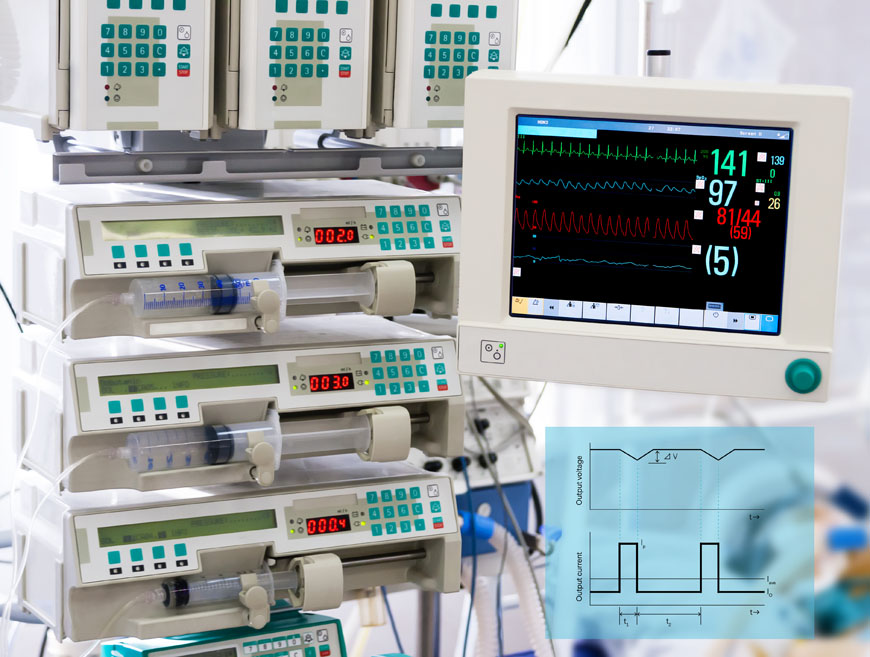 Figure 01 – Infusion pumps and typical peak load behavior (Source: PRBX/ Superstar-Shutterstock) |
In addition to the output voltage and power, the type of load will determine what factors are important for the system designer to consider. There are many possibilities and in some equipment the main power supply could power a variety of systems and sub-systems with different load profiles which is obviously more complex to address. To simplify, we will list four basic types of loads: inductive, capacitive, constant current, and nonlinear resistive. Each of them has a specific behavior requiring attention when selecting a power supply for each such applications.
Loads types in short:
Inductive load: Loads such as motors and electromagnetic switches (e.g., relays, magnet switches) with an inductive characteristic are referred to as inductive loads. At the moment of applying a voltage to a DC-motor, a current multiple times the rated value will flow through the load; while at the moment of cutting the voltage off, due to the inductive component of the load, a voltage of counter electromotive force E= -L× (di / dt) will be generated. Generally, when applying a voltage to an inductive load the power supply can sustain the energy required by the peak demand only up the limit of its overcurrent protection (OCP) function (Figure 02). Exceeding the limit, even if only for a very short time, can cause the power supply to stop. This is the reason why the peak load must be well defined in order to select an appropriate power supply with an overcurrent protection that allows the surge power for a definite time and sequence. Also, when turning the output voltage off, due to the counter electromotive force generated (in most cases, it is absorbed by the electrolytic capacitors in the power supply), the overvoltage protection circuit of the power supply may be triggered, and the power supply cease output. In this case measures such as including a reverse voltage protection diode should be exercised.
Capacitive load: A load with a capacitance component is called a capacitive load. For example, the capacitors inserted for the purpose of reducing the ripple voltage of the power supply, and capacitors used for coping with peak loads, etc. For this kind of load, at the moment of applying a voltage a very large charging current ipeak = (V/R) with R being the (parasitic) series resistance, will flow due to there being no charge in the capacitor. Although the power supply can detect and control the output voltage, if a large value capacitor (over several tens of thousands of microfarads) is inserted into the output side, such control may not be able to realize what is happening, and the output voltage may become unstable. It is important for system designers to consider the total amount of capacitance installed in their equipment and to verify the power supply's ability to deliver the required peak energy needed to efficiently charge the load which in some applications could be several Farads.
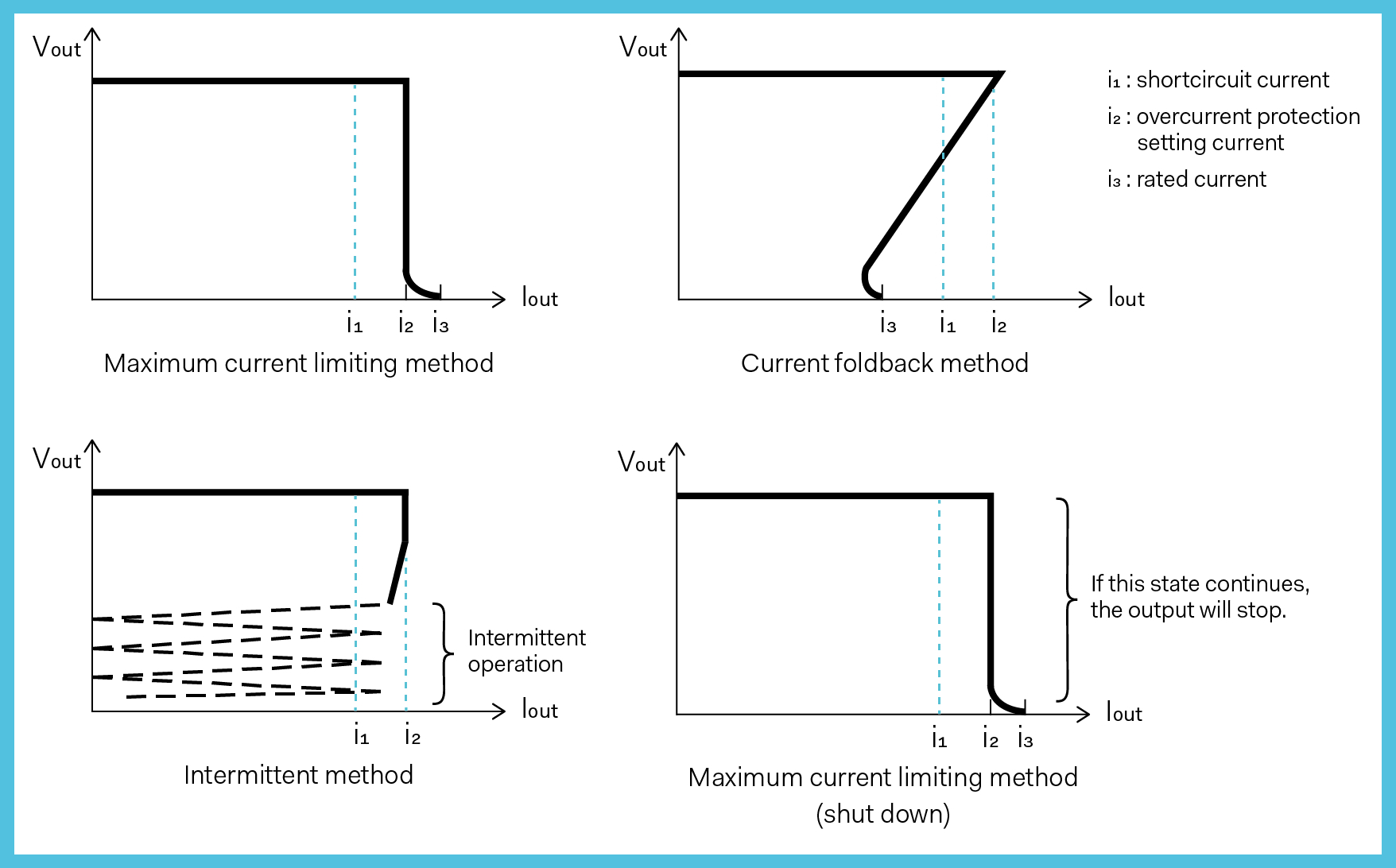 Figure 02 – Typical overcurrent protection curves (Source: PRBX/ COSEL) |
Constant current load: A load where the current stays constant although the load voltage varies is called a constant current load, an example being LED lighting in surgical theaters. It is important to consider the type of overcurrent protection built into the power supply. If for example the overcurrent protection characteristic of the power supply is a current fold back type, the output voltage may not be able to rise (Figure 02). This is because the output voltage stabilizes on the drooping line of the overcurrent protection characteristic of the power supply from applying a voltage to reaching the rated voltage. Generally, by changing the overcurrent protection characteristic to a maximum current limiting type the problem can be solved.
Non Linear Resistive: Some equipment uses heating elements or lamps with filaments where the resistance changes when current flows through it. Though this warm up phase with a monotonic resistance change might only last for a short time, for the power supply it may look like a constant current exceeding the threshold value for its built-in overcurrent protection.
Overcurrent protection is a very important part of a power supply. It guarantees the power unit in the case of an excess power situation that may occur accidentally or as result of an equipment failure, will protect the equipment and will eventually flag the fault by way of a signal to the operator, e.g. a LED or a signal transmitted by the communication BUS.
Overcurrent protection overview
As previously explained, when the output current/power exceeds a defined limit, several types of damage could occur within the power supply or in the equipment being powered. Besides preventing the current from exceeding a rated value, the protection circuit also plays the role of limiting short circuit current. Depending on the type of application and specific system requirements, when OCP is activated a number of effects may result, the output could be switched off permanently with a manual reset, switched off temporarily with an automatic reset, or behave as a fixed, but safe level constant current (Figure 02).
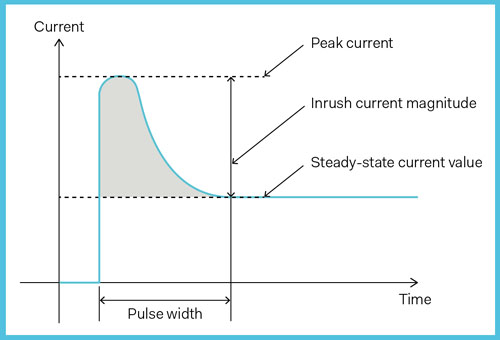 Figure 03 – Peak current at startup when charging capacitors (Source: PRBX) |
When a power supply or an electrical device is turned on, high initial current flows into the load, ramping up until it reaches a peak value. The main reason for this initial peak is to charge the large decoupling or smoothing capacitors within the power supply and final equipment. During this sequence, as the capacitors charge or devices come out of a cold state, the current increases very quickly from zero, rising all the way to the peak current and then decreasing gradually to the steady state current (Figure 03). During this period the power supply must deliver enough energy to charge the capacitors, and supply the required power to the load without activating the over-current protection (OCP) thus shutting down the output. Also, some loads might initially behave as a short-circuit and require the power supply not to go into protection mode. To accommodate this start-up sequence, power supplies are designed to allow a certain level of overcurrent, and it is common to set the OCP threshold at around 110% of the maximum rated value.
110% is good enough for the vast majority of applications though in the case of demanding medical equipment requiring peak power levels in the range of 200-300% for seconds, 110% will not suffice, requiring a power supply designed not only to deliver a high peak power, but to guarantee the highest reliability during the overall lifetime of the final equipment.
Running a marathon at sprint performance levels!
A simple way to guarantee the power supply will deliver enough energy when extra surge power is required is to choose a power unit rated for the maximum power required during the peak demand. For example, if the maximum steady power required by an apparatus is 500W and the peak is 1000W, then taking into consideration the operating conditions e.g., input voltage, environmental temperature, derating, etc., the system designer could consider a 1200W power supply as the most suitable solution.
This seems to be obvious, but is overkill when the peak is only happening occasionally. For example when a DC motor is activated for positioning a patient's bed then switched off and the power supply is again only powering the control system. Similarly this would be overkill for systems requiring repetitive peak loads for a limited time compared to steady state power.
Choosing a power supply for peak load applications requires one to evaluate the operating conditions during the lifetime of the equipment, and to take into consideration all aspects including size, weight and price. Buying a 1200W power supply, when peak load represents only a limited portion of the operation, might not be the best option.
Power supply manufacturers have developed power solutions able to deliver significant extra power in the range of twice nominal, or even more than the maximum rated, for a significant duration. This requires the power unit to be designed to host enough capacitors (Figure 04) but also to have a power-train able to sustain repetitive peak demands without over-heating or adversely affecting reliability.
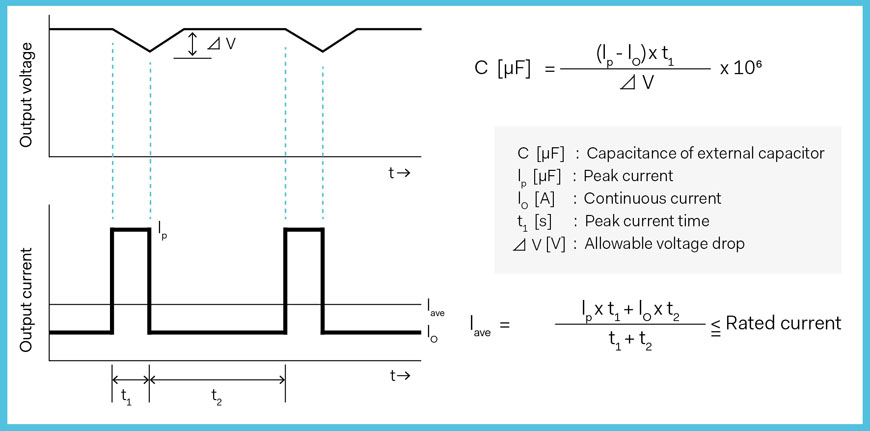 Figure 04 – Design equation to guarantee output capacitors to sustain required peak energy (Source: PRBX) |
As an example, consider the output voltage behavior of the COSEL 600W AEA600F series (Figure 05) when applying a peak load to the output. The tested product is a 600W rated power unit, delivering 24V at a nominal current of 25A. As presented in Figure 06, the power-train and output capacitors have been selected to sustain a peak power twice nominal for a duration of 1000 milliseconds. Two conditions are represented in Figure 06: From no load to 52.5A peak, and from 12.25A half-load to 52.5A peak. In both conditions, the voltage remains within the specified limits, and OCP is not shutting down the output.
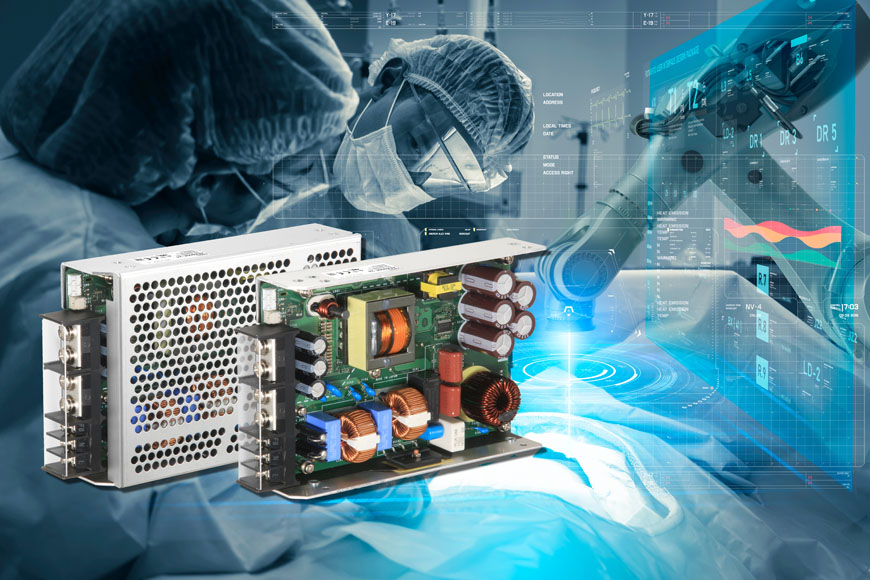 Figure 05 – COSEL 600W power supply for medical applications with peak load capacity up to 300% (Source: PRBX/COSEL/WHYFRAME-Shutterstock) |
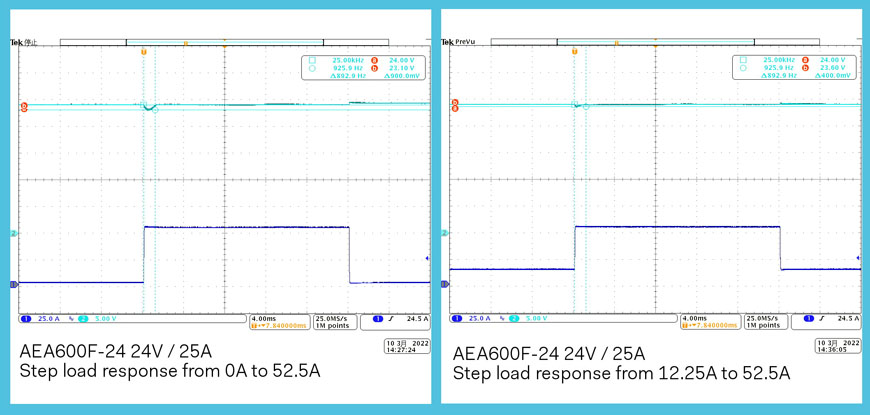 Figure 06 – COSEL AEA600F peak load test in two conditions (0 to 200% and 50% to 200% load) (Source: PRBX/COSEL) |
Conclusion
Running a marathon with sprint-race performance levels in medical power supplies is a reality, and while the great variety of applications require different types of power supplies, technology is making it easier for system designers to choose the right products for their applications. This is without mentioning the fantastic opportunities brought about by new technologies such as Wide Band Gap semiconductors, Supercapacitors, and digital control coming to the next generation of power supplies, and making power designers' lives so exciting.
References:
Powerbox (PRBX):
https://www.prbx.com/
|
Provided by Patrick Le Fèvre
|
 |
At the APEC 2022 Plenary Session, John H. Scott, Principal Technologist, Power and Energy Storage, NASA Space Technology Mission Directorate presented a very interesting topic: 'On the Moon to Stay', covering the various aspects of power electronics that would be required to make that statement feasible. Space exploration has not only been a dream and a source of imagination, but also an amazing research area seeking to break 'unbreakable' limits, and in the processing providing benefits to many applications we are now using daily on planet Earth.
 Figure 01 - O’Neill Cylinder interior - Painting by Rick Guidice (Source: PRBX/NASA)
Figure 01 - O’Neill Cylinder interior - Painting by Rick Guidice (Source: PRBX/NASA)
Taking humans first to the moon, later to Mars and who knows where to next, is far from being an easy job; making life possible and sustainable in such hostile environments is much more than just 'a challenge'. One example is how to feed the space explorers when they are so remote from planet Earth? When considering Mars, it would take 210 days and a significant cost and risk for a re-supply rocket to arrive, which is clearly not an optimum solution. Space farming has been part of that dream and we all remember the O'Neill Cylinder, designed by Princeton physicist Gerard K. O'Neill who published in 1974 an article in Physic Today: 'The Colonization of Space'. O'Neill's article and research fueled a number of sci-fi movies showing the huge rotating cylinder, hosting farms and lit by an artificial sun (Figure 01). We are not there yet, but on that basis the first humans to inhabit Mars may be considered farmers more so than astronauts! So how will power electronics contribute to make the dream a reality?
From Earth indoor farming to Space: Feeding 10 billion people on Earth
Let's start by looking at Earth. If we consider the latest estimation, Earth's population is expected to reach 10 billion by 2050. Simultaneously we are facing climate changes that could impact the complete food ecosystem and require significant modifications to the ways in which we produce and consume food.
Considering all the parameters and requirement to produce food with the highest respect for the environment, in 1999, Dr. Dickson Despommier with his students developed the idea of modern indoor farming, revitalizing the terms coined in 1915 by the American geologist Gilbert Ellis Bailey: "Vertical farming." We have all heard about it and even read articles about industrial buildings that were converted into vertical farms, but from the early days using fluorescent or halogen lighting to Solid State Lighting (SSL), there have been an amazing number of technological innovations that contribute to the effort to optimize the energy delivered to the plants for optimal growth. With these advances, the benefits of indoor farming multiplies. If we consider space utilization, 100 times more food could be produced per square meter compared to traditional agriculture, reducing water utilization by 90% and hazardous chemicals to none. Indoor farming is very attractive but to be really efficient such agriculture requires a very efficient lighting system (Figure 02).
 Figure 02 - Solid State Lighting to grow vegetables in indoor farming (source PRBX / asharkyu-Shutterstock)
Figure 02 - Solid State Lighting to grow vegetables in indoor farming (source PRBX / asharkyu-Shutterstock)
Not all vegetables can grow with limited soil and nutrition by impregnation but for the ones compatible with this farming method, the results are impressive and can be further improved by using modern lighting technologies that are computer-controlled. This is very interesting area which for power designers to explore, combining advanced power electronics and modern agriculture, while keeping software in mind.
Since its introduction, indoor farming engineers conducted research to determine the spectrum and energy required by different plants to grow efficiently. From wide spectrum fluorescent or halogen lamps to narrower spectrum, the conventional lighting industry innovated a lot but these technologies are not flexible nor efficient enough to respond to the demand.
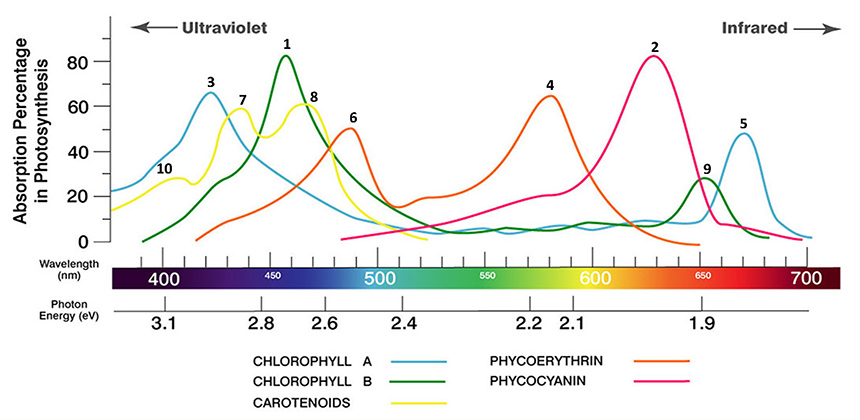 Figure 03 - The light spectrum to grow plants and vegetables typically starts at 450 nm (blue light) and goes through 730 nm (far red) (source PRBX)
Figure 03 - The light spectrum to grow plants and vegetables typically starts at 450 nm (blue light) and goes through 730 nm (far red) (source PRBX)
In Japan from 2005-2008, agronomical researchers experimented with different lighting methods to adjust spectrum and energy to specific plants. Researchers concluded that the optimal light spectrum to grow plants and vegetables typically starts at 450 nm (blue light) and goes through 730 nm (far red) (Figure 03). The Photosynthetic Photon Flux Density (PPFD) required ranges from 50 micromoles (µmol) for mushrooms up to 2,000 micromoles for plants like tomatoes and some flowers that thrive in full summer light (Figure 04).

Figure 04 - Light energy required ranges from 50 micromoles (µmol) for mushrooms up to 2.000 micromoles for light intensive plants (source PRBX/ barmalini - Shutterstock)
Agricultural experts advise that for optimal results different plants require different light spectra as well as differing light balances and intensities at different stages of growth, from seedling through harvest. This often results in the need for the artificial light to have a number of different spectra channels that are individually adjustable for intensity. Some crop growing practices combine different sources of lighting, including the use of UV flashes to prevent the development of parasites, requiring a power supply able to switch from constant voltage to constant current within a range from almost zero to the maximum (Figure 05). This specification for a power supply is very much what will be required for Space Farming, in addition to a power electronics architecture able to combat the effects of space radiation.
Bringing Earth farming to Space
As NASA plans long-duration missions to the Moon and Mars, a key factor is figuring out how to feed crews during their weeks, months, and even years in space. Food for crews aboard the International Space Station (ISS) is primarily prepackaged on Earth, requiring regular resupply deliveries. Now, while it is feasible for the ISS to be resupplied by cargo spacecraft, clearly it would be much more complicated and expensive to use this method on Mars, which is at an average distance of 220 million km (140 million miles) and more than 200 days traveling.
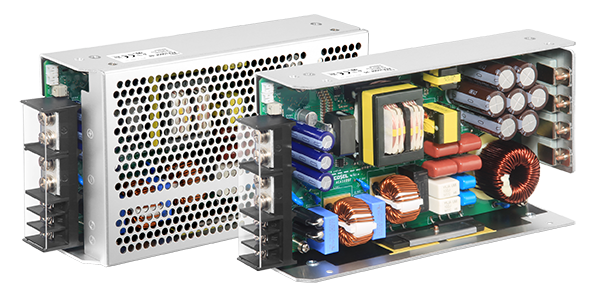 Figure 05 – COSEL power supply with multi-modes for voltage or current constant from max to near zero (Source PRBX/COSEL)
Figure 05 – COSEL power supply with multi-modes for voltage or current constant from max to near zero (Source PRBX/COSEL)
In 2015, NASA in association with the Fairchild Botanical Gardens in Miami began a project called 'Growing Beyond Earth' to define what plants would be suitable for autonomous space-farming. After a series of experiments which took into consideration the full development cycle, the variety of plants that were selected for further research included lettuces, mustard varieties, and radishes. These crops were first grown in a controlled lab on Earth, then in the ISS to study how plants are affected by the micro-gravity and other factors (Figure 06).
 Figure 06 - NASA astronaut Peggy Whitson looks at the Advanced Astroculture Soybean plant growth experiment (Source: PRBX/NASA)(Source PRBX/NASA)
Figure 06 - NASA astronaut Peggy Whitson looks at the Advanced Astroculture Soybean plant growth experiment (Source: PRBX/NASA)(Source PRBX/NASA)
The 'Veggie' project included a large number of experimental factors such as "Pick-and-Eat Salad-Crop Productivity, Nutritional Value, and Acceptability to Supplement the ISS Food System (Veg-04A)" and included research on the optimum lighting conditions to grow plants. On the ISS, two light treatments with different red-to-blue ratios were tested for each set of crops to define light colors, levels, and horticultural best practices to achieve high yields of safe, nutritious leafy greens and tomatoes to supplement a space diet of pre-packaged food, and later for Moon or Mars farming. A number of reports have been released including 'Large-Scale crop production for Moon and Mars: Current gaps and future perspectives' published in February in 'Frontiers in Astronomy and Space Sciences' summarizing seven years of experimentation on Earth and in the ISS (Figure 07).
https://www.psma.com/HTML/newsletter/pics/prbxa_047_figure_07_space-far…" width="90%" />Figure 07 – Examples of Kennedy Space Center 8KSC) prior, current and future space crop production platforms selected and designed to lead to crop production units destined for the Moon or Mars (Source PRBX/NASA)
Considering the different varieties of plants that will be grown, and the distance and cost, the power supplies for space-farming will have to accommodate different power profiles combining constant current or constant voltage, peak power, and must also be energy efficient and small in size. That's in addition to specific constraints related to space, including immunity to radiation, operating temperature, shock and vibration.
The importance of optimizing the payload, the weight and size of everything is a big concern for space applications. For all applications, from low orbit satellites to out-of-space exploration, power supplies have been developed with very advanced technologies to make them smaller and energy efficient.
Wide Band gap (WBG) semiconductors in space applications have formed a part of many research projects, and it's worth mentioning the report presented by NASA, in 2018, at the (RADECS) conference in Gothenburg: 'Radiation and its Effects on Components and Systems'. This identified the strengths and weaknesses of WBG when exposed to radiation. The recent announcement about the newly funded national collaboration led by Penn State to better predict and mitigate radiation-induced damage of WBG semiconductors is interesting. The U.S. Department of Defense awarded the team a five-year, $7.5 million Defense Multidisciplinary University Research Initiative Award. This clearly shows the high level of importance of WBG in space applications and their contribution to the next step.
In parallel, the semiconductor industry is moving forward. One example is the new division and products for space applications launched by Efficient Power Conversion (EPC). For power designers, having access to COTS ruggedized GaN for space applications will reduce the development time and cost when developing power supplies for space applications (Figure 08).
 Figure 08 – Efficient Power Conversion (EPC) ruggedized GaN FET for space applications and DC/DC converter (Source: PRBX/EPC)
Figure 08 – Efficient Power Conversion (EPC) ruggedized GaN FET for space applications and DC/DC converter (Source: PRBX/EPC)
Conclusions:
Although one of the biggest challenges to in-spaceship farming is sourcing enough water and nutrients and then cycling them as efficiently as possible, there are many other obstacles we don't have to grapple with on Earth that will need to be considered too, such as cosmic radiation, lack of an atmosphere, and low levels of light. From the 2015 'Growing Beyond Earth' project to current advances in 2022, a lot of progress has been made, contributing to a better understanding of space farming, as well as in power electronics. We are in the early stages of a whole new era in which Wide Bandgap semiconductors in power electronics will play an important role.
Exciting time for power designers, isn't it?!
References:
Powerbox (PRBX):
https://www.prbx.com/
The Colonization of Space – Gerard K. O'Neill, Physics Today, 1974
https://space.nss.org/the-colonization-of-space-gerard-k-o-neill-physics-today-1974/
Fairchild Botanical Garden
https://fairchildgarden.org/gbe/
Growing Beyond Earth
https://www.nasa.gov/feature/students-help-nasa-researchers-decide-what-plants-to-grow-in-space
NASA / RADEC 2018
Jean-Marie Lauenstein – NASA GSFC, Greenbelt, MD, USA
Wide-Bandgap Semiconductors in Space: Appreciating the Benefits but Understanding the Risks
Frontiers in Astronomy and Space Science
Large-Scale Crop Production for the Moon and Mars: Current Gaps and Future Perspectives
Published 04 February 2022 / doi: 10.3389/fspas.2021.733944
Efficient Power Conversion (EPC)
https://epc-co.com/epc
Applied Power Electronics Conference (APEC)
https://apec-conf.org/
Provided by

Patrick Le Fèvre
Chief Marketing and Communications Officer, Powerbox
The Power Sources Manufacturers Association (PSMA) is pleased to announce that a new slate of officers has been elected to lead its Board of Directors for the 2022-2024 term. The new officers are Fred Weber (Future Technology Worldwide), Chair; Trifon Liakopoulos (EnaChip Inc.), President; Renee Yawger (Efficient Power Conversion (EPC)), Vice President; and Tim McDonald (Infineon Technologies), Secretary/Treasurer.
Fred Weber expressed appreciation for Mike Hayes' leadership as Chair from 2020-2022. "The past 2 years have been difficult due to the unprecedented challenges of the pandemic and resulting impact on APEC2020 and 2021 and the many workshops sponsored and co-sponsored by the PSMA Technical Committees. Mike not only navigated these challenges but also focused the PSMA Executive Committee with a number of innovative and lasting projects." Fred looks forward to continuing this work and noted "PSMA's success relies on the active participation of our members, especially through the many Technical Committees. The Board welcomes and encourages all companies in our industry to become part of this unique industry organization."
The twelve members of the Board are elected by the member company representatives to serve three-year terms, with four members rotating off each year. The full board of directors for 2022-2023 are:
- Fred Weber, Future Technology Worldwide - Chair
- Trifon Liakopoulos, EnaChip Inc. – President
- Renee Yawger, Efficient Power Conversion (EPC) – Vice President
- Tim McDonald, Infineon Technologies – Secretary/Treasurer
- Ada Cheng, AdaClock
- Dhaval Dalal, ACP Technologies LLC
- Thomas Foulkes, Pacergy LLC
- Reenu Garg, Microchip Technology
- Ajay Hari, onsemi
- George Slama, Wurth Electronics
- Llew Vaughan-Edmunds, Navitas Semiconductor
- Brian Zahnstecher, PowerRox, LLC
As is the case in many industries, power electronics has been impacted by the Covid-19 pandemic. This includes a boost in new technologies and opportunities for power designers to capitalize on the benefits of E-learning. While it is always difficult to derive trends from large industries, as we get closer to APEC 2022, as a power engineer it is interesting to take a minute to ponder and consider what will contribute to making power supplies more efficient, more reliable and exciting to design.
Overall trends and technology
A major trend that we are all aware of is the 'electrification' and transition from fossil fuels to renewable energy. There are a lot of technological innovations required in this segment to reach the carbon neutral level expected by the European Commission, US DOE and similar initiatives in Asia. If we focus on what most of the power supplies companies are developing, I foresee that four trends, all of which will benefit from the implementation of Wide Band Gap Semiconductors, will influence the power industry in 2022:
- Reducing energy consumption
- Power supplies becoming part of the Machine-to-Machine eco-system
- Enhanced energy storage solutions
- Acceleration of harvesting energy solutions,
In the quest for reduced energy consumption, from harvesting energy to the grid, the power electronics industry is seeking new long term solutions to improve efficiency. International and local regulations have already forced power supply manufacturers to innovate, and we are seeing more stringent regulations under discussion that would require the power industry to further explore new topologies, components and materials.
One example that illustrates and will benefit from this trend is E-commerce.
E-commerce was already growing before Covid-19, but as consequence of curfews, working at home, and the drastic reduction of physical interaction, it has grown exponentially, putting a high demand on shipping hubs, computerized storage and the overall supply chain. Before we even mention the associated datacenters required to manage the E-commerce process, there are the shipping hubs and warehouses that have become gigantic and consume lots of energy. Making these hubs more energy efficient has been on the agenda for all the major players, and the 2020-2021 peak on demand was a strong a signal for the need to reconsider the way to use and to manage energy.
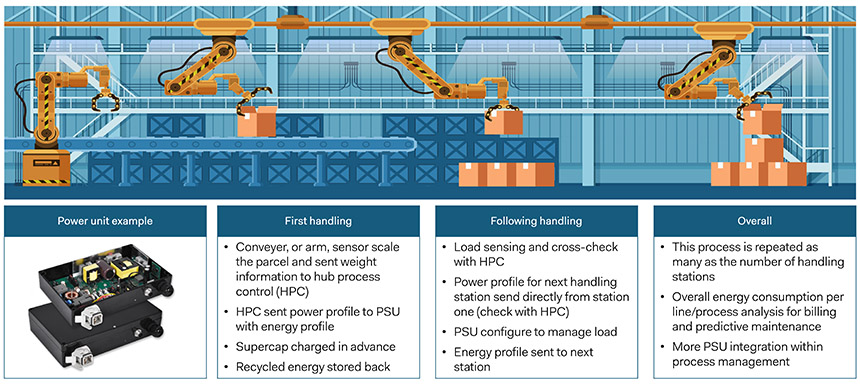 Figure 01: Smart Power operation in Smart Factory with machine-to-machine communication (Source: PRBX) Figure 01: Smart Power operation in Smart Factory with machine-to-machine communication (Source: PRBX) |
Power supplies as such are not consuming the majority of this energy, but, when one considers their strategic position in the operational chain, they become a key point in the overall process to optimize how energy is used in the complete chain. In 2022 we will see very advanced power supplies used in E-commerce handling and shipping hubs. Not only will they integrate higher levels of communication, they will also be able to store and restore energy from supercapacitors banks, reducing peak disturbances on the grid and consumption. Already experimented with in 2021, the power supplies have been integrated into a complete eco-system with Machine-to-Machine communication (Figure 01). They not only deliver power to a load e.g. conveyor motors, but they are able to sense and adjust the level of energy to store in local supercapacitors bank (Figure 02).
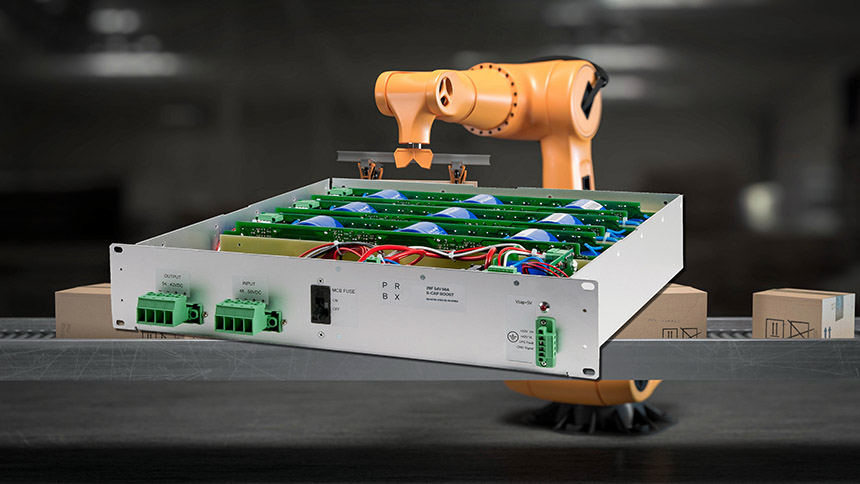 Figure 02 - PRBX S-CAP BOOST supercapacitors bank with digital control and communication interface able to deliver peak energy to load and to store backward energy (Source: PRBX) Figure 02 - PRBX S-CAP BOOST supercapacitors bank with digital control and communication interface able to deliver peak energy to load and to store backward energy (Source: PRBX) |
Almost invisible, from the RFID inserted in the shipping box that will get power from RF signals, to sensors placed on motors or moving elements powered by vibration, micro-systems powered by harvested energy are developing very quickly. Additionally, the nanotechnology, such as nanotubes, make it possible to develop very small supercapacitors able to store enough energy to power sensors and transmitters.
To make this possible, the implementation of digital power and communication is a must, but the level of performance will also require power electronics engineers to design new power solutions with the so called 'Wide Band Gap' semiconductors. Depending on the application and voltage required they may select GaN or SiC types, but the benefits of WBG will contribute to making E-commerce more energy efficient and to reducing the carbon footprint.
Critical building blocks!
For decades the improvements in energy efficiency levels of power supplies have been made possible by technological evolutions. Moving from linear to switching technology was an early major one, followed by a number of more minor leap-frogs until digital power came to market.
Despite it having been on the market for several years, with the emerging WBG technology and the possibilities offered by those components, digital control becomes an absolute MUST and I strongly believe it will be a major building block for power designers when developing new products.
For components, the WBG transistors are without doubt the ones that will prevail in 2022. That said, conventional Power FETs are also making big progress and power designers will have to achieve new levels of business assessment and acumen when selecting the most appropriate technology for their applications.
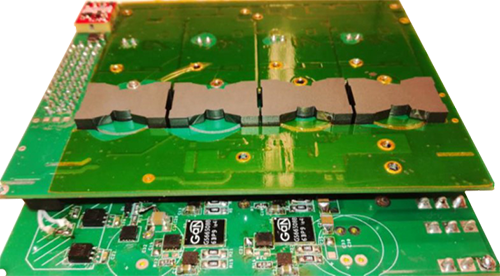 Figure 03 - PRBX multi-cores auto-tuned power converters with advanced digital control and GaN FET transistors (Source PRBX) Figure 03 - PRBX multi-cores auto-tuned power converters with advanced digital control and GaN FET transistors (Source PRBX) |
The third building block I foresee as important is the advanced planar transformer with interleaved multi-core technology. Not all power supplies require megahertz switching but considering the constant quest for smaller power supplies with higher efficiency, power designers will have to consider new types of transformers and new winding techniques. In that respect they will not only be helped by ferrite manufacturers developing new materials but also by Artificial Intelligence software that can shorten the time to design and test new transformer types (e.g., Frenetic, Simba).
One specific example of this is research currently being conducted at PRBX, combining digital control, GaN, and multicore transformers with advanced wiring and auto-tuned performance within the wide operational range that is seen in some industrial applications that require extremely wide input voltage ranges, as well as outputs subject to repetitive peak loads. Final products while not ready yet will not be possible without the combination of digital control, WBG and advanced magnetics (Figure 03).
I believe many of the new products that we will see in 2022 and onwards will be based on these three building blocks, which I'm sure will also include more communication to become part of a Machine-to-Machine ecosystem.
In WBG we trust!
One interesting aspect about Wide Band Gap semiconductors is that we are seeing a similar situation to when the first power MOSFETs were launched. Some immediately considered the benefits of the WBG, despite early products that were based on a depletion mode that required very specific drivers and were not very user friendly, it didn't take too long for power semiconductors manufacturers to provide 'easy-to-use' solutions.
It has now been more than five years since manufacturers first promoted the benefits of that technology but if the Go To Market is ready, the Go To Application for mass users still requires a certain amount of time.
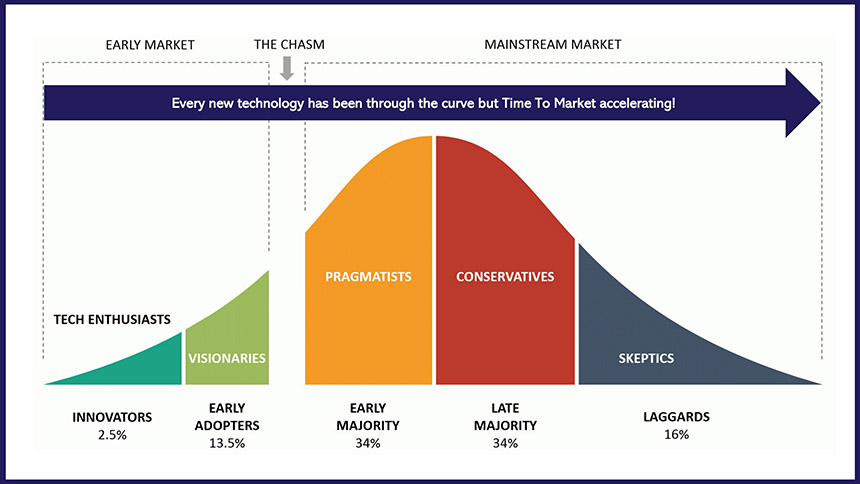 Figure 04 - Experienced power designers have crossed that technological chasm many times, with the latest one being the migration from analog control to digital (Source: PRBX) Figure 04 - Experienced power designers have crossed that technological chasm many times, with the latest one being the migration from analog control to digital (Source: PRBX) |
We are all familiar with the 'camel-back' curve reflecting new technology adoption and crossing the chasm. Experienced power designers have crossed that technological chasm many times, with the latest one being the migration from analog control to digital, which took more than 10 years to reach a significant level of adoption (Figure 04).
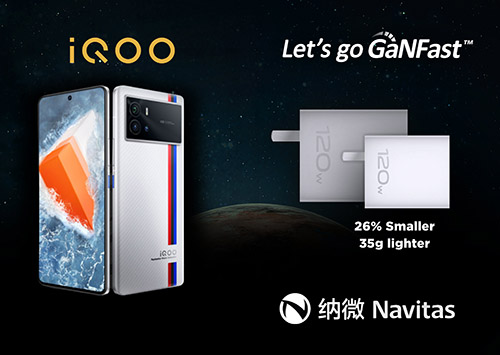 Figure 05 - Navitas' next-generation GaNFast power IC that will drive the 120W ultra-fast charger, contributing to reduce its size by 26% (Source PRBX/Navitas) Figure 05 - Navitas' next-generation GaNFast power IC that will drive the 120W ultra-fast charger, contributing to reduce its size by 26% (Source PRBX/Navitas) |
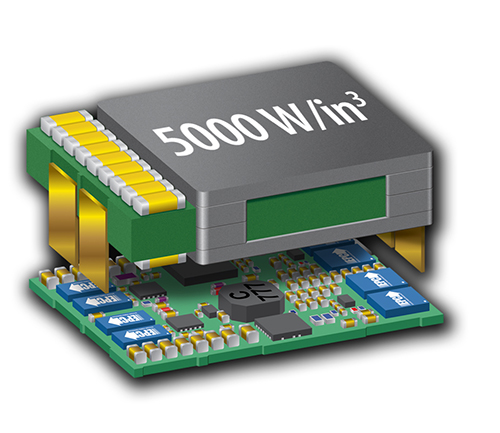 Figure 06 - Efficient Power Conversion (EPC) approach is very interesting, minimizing interconnection losses, and making it possible to shrink a power converter to an unprecedented size (Source: PRBX/EPC) Figure 06 - Efficient Power Conversion (EPC) approach is very interesting, minimizing interconnection losses, and making it possible to shrink a power converter to an unprecedented size (Source: PRBX/EPC) |
In the case of WBG, and especially Gallium Nitride (GaN), early adopters entered the fray much quicker than some had predicted a few years ago. It is no surprise that the PC and Mobile/Nomad industries were some of the early adopters. The number of USB-C chargers using GaN semiconductors announced in 2020-2021 is very impressive. Particularly worthy of mention is Navitas' next-generation GaNFast power IC that will drive the 120W ultra-fast charger supplied 'in-box' with vivo's iQOO-brand flagship iQOO 9 Pro mobile phone, demonstrating the rapid adoption of GaN by the 'nomad' industry. But it is not just the electrical performance, using GaN also reduces the physical size by 26%, reaching a stunning 1.3W/cc power density, which is quite incredible (Figure 05).
While it took 10 years for digital power to become a de facto technology, it took only five years for WBG to reach a similar level.
What is interesting in the development of the WBG semiconductors is that due to the specificity of this technology, with very low internal resistance and the ability to switch very fast, the packaging is very important and we see a lot of innovation from manufacturers to offer optimized solutions. Technologywise the Efficient Power Conversion (EPC) approach is very interesting, minimizing interconnection losses, and making it possible to shrink a power converter to an unprecedented size (Figure 06).
Of note is the amazing number of technical webinars held during the Covid-19 era, not to mention the virtual APEC 2021. Many companies have taken that as an opportunity for their power designers to attend online training, and as a result some power-semiconductor companies have reported shipping up to 10 times more evaluation kits than before the pandemic days.
If we simplify the market into two segments: High voltage (using SiC) and Low voltage (using GaN), we see two different patterns. High voltage applications such as electric vehicles and solar are already familiar with SiC transistors, and for that segment it is no big revolution for power engineers to undergo a learning phase for the relatively new low voltage technology.
In conclusion
In many different ways we have all been affected by the pandemic, although looking back it has contributed to a boost in learning new technology and speeding innovation. Considering all of that, 2022 will be a very important year for WBG and we can expect many new power supplies (AC/DC and DC/DC) to be announced during the year. 2022 will be a very exciting year for all of us designing power solutions.
References:
Powerbox (PRBX): https://www.prbx.com/
Navitas Semiconductors: https://navitassemi.com/
Efficient Power Conversion (EPC): https://epc-co.com/epc
Frenetic https://frenetic.ai/
SIMBA https://simba.io/
Applied Power Electronics Conferences (APEC) https://apec-conf.org/
|
Provided by Patrick Le Fèvre
|
 |
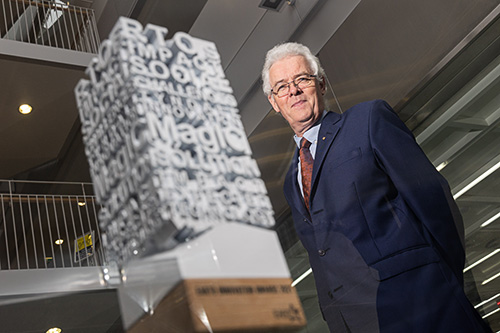 Professor Cian Ó Mathúna with the 2021 EARTO Innovation Professor Cian Ó Mathúna with the 2021 EARTO InnovationAward for Impact Expected |
![]() ne of PSMA's long-time contributors and supporters, Professor Cian Ó Mathúna, from Tyndall National Institute in Cork, Ireland has been recently named the recipient of two major international awards celebrating innovative technology created in Ireland, which could have a lasting environmental impact.
ne of PSMA's long-time contributors and supporters, Professor Cian Ó Mathúna, from Tyndall National Institute in Cork, Ireland has been recently named the recipient of two major international awards celebrating innovative technology created in Ireland, which could have a lasting environmental impact.
Minimizing energy consumption in electronics continues to be a major, technological challenge. Responding to this challenge, Cian, who is currently Head of MicroNano Systems at Tyndall, has, over the last 27 years, developed MagIC (Magnetics on Silicon), an innovative technology that can greatly extend the battery life of portable electronics and dramatically reduce the energy use of high-performance electronic systems and equipment.
The ground-breaking impact of the technology has been recently recognized with prestigious awards from the 400,000 member IEEE (Institute of Electrical and Electronics Engineers) and EARTO (European Association of Research and Technology Organisations).
The IEEE Power Electronics Society Technical Achievement Award for Integration and Miniaturisation of Switching Power Converters celebrates Cian's extraordinary, global influence and leadership over the last decade in bringing together the electronics industry and academia to collaborate toward the development of the Power Supply-on-Chip (PwrSoC).
Tyndall is the first Irish recipient of an EARTO Award, which recognizes key contributions from European research to high-impact, technological innovation. The 2021 EARTO Innovation Award for Impact Expected looks to the future and recognizes the impact Professor Ó Mathúna's research will have on the technology of the future. Including dramatically reducing system energy consumption, extending battery life and reducing the overall size, weight and cost of future electronic systems.
Tyndall's MagIC technology makes bulky magnetics components in electronic equipment to disappear onto the silicon chip, just like Gordon Moore and colleagues did with the transistor over 50 years ago. Using MagIC technology, electronics will be able to use power more efficiently by minimizing the energy wasted or lost as the battery powers the multiple-voltage rails required in multi-core microprocessor chips and/or other complex SoC chips. This improved efficiency can extend the charge time of batteries by more than 50%. The breakthrough technology will have a huge impact on markets for mobile phones, IT equipment, and any device needing a battery. It is also envisaged that the technology will deliver significant energy savings in servers in the data centre and high-performance computing space.
Professor Ó Mathúna said, "This ground-breaking and disruptive innovation is set to change the global approach to how power is managed in electronic devices and will contribute to addressing a critical environmental issue for society and our planet. We continue to partner extensively with global companies to develop and commercialize the technology which has already received more than €20M in funding from research, licensing and productization. We have joint publications with companies such as Global Foundries in Dresden and Singapore; Intel, USA; Philips in the Netherlands, TI in the USA; Wurth Electronics in Germany as well as a joint patent with Apple Computers."
Cian joined the November 2021 PSMA Board of Directors meeting and was very gracious and effusive in acknowledging the influence PSMA has had on the emergence of PwrSoC over the last 3 decades. Cian mentioned that he was first introduced to PSMA by Don Staffiere who managed to convince one of his Irish clients, Gary Duffy, then MD of Computer Products (later Artseyn Technologies) to fund Cian's attendance at the 1994 APEC. Cian came to APEC with a very limited background in power electronics but, through Don's introductions to PSMA, he began participating in the PSMA Technology Roadmap initiative, and was quickly able to leverage his expertise in microelectronics packaging which was just beginning to have a very positive impact on the miniaturization and integration of power electronics products.
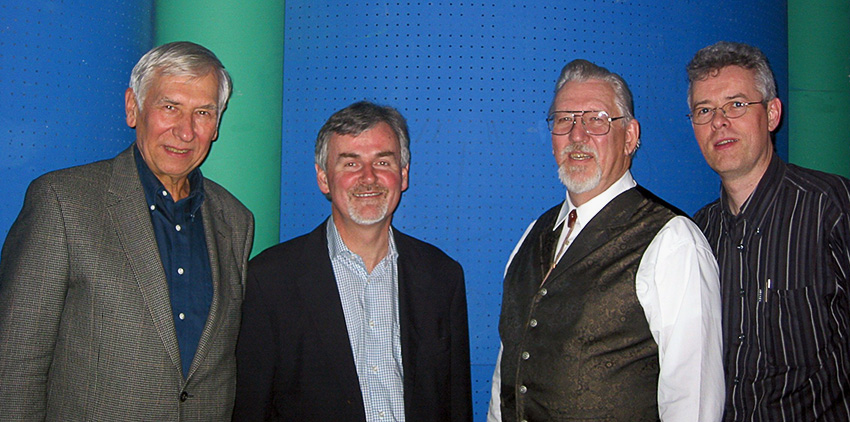 Joe Horzepa, Gary Duffy, Arnold Alderman and Cian Ó Mathúna at APEC in the mid 2000s Joe Horzepa, Gary Duffy, Arnold Alderman and Cian Ó Mathúna at APEC in the mid 2000s |
With the support of Don Staffiere, Bob Huljak, the late Prof. William Sarjeant and the strategic guidance and wisdom of Joe Horzepa (and Judy!), Cian engaged with Arnold Alderman and Doug Hopkins to run the Packaging Technical Committee with Brian Narveson and Ernie Parker later contributing their expertise. Around 1997/98, PSMA awarded NMRC (National Microelectronics Research Centre – the precursor to Tyndall) funding to undertake a special project on the state-of-the-art in commercial 3D power electronics packaging and followed this, in 2006/2007, with funding, for Tyndall and Anagenesis, on the very first study on fully-integrated power – the visionary and seminal "PSiP2PwrSoC" project.
Looking back, Cian sees this project as the inspiration for him to establish PwrSoC, the International Workshop on Power Supply on Chip which was first held in Cork in 2008 with over 100 international participants. At PwrSoC2010, Tyndall agreed to hand over the workshop to PSMA and the IEEE Power Electronics Society from which point the Workshop has become recognized as the flagship technical forum worldwide for both industry and academia to get together to discuss both the technological and business challenges and opportunities for PwrSoC.
In his closing remarks, Cian commented "the vision and strategic perspective of PSMA, over the last 27 years, has had a dramatic impact on seeding research in power electronics, on providing a dedicated forum to gain insight into major power industry challenges and, in particular, in providing me, and the wider team at NMRC/Tyndall, with the international perspective to succeed. For all of this, I am forever in PSMA's debt."
![]() ver the years I have worked with various safety, compliance, and certification agencies and NRTLs (Nationally Recognized Testing Laboratories) and similar types of labs. Let's call them businesses who make money from certifying products of various sorts. In the past, before legal, finance and operations ruled the world, some of these agencies were not-for-profit organizations which were funded by insurance companies to enhance safety and minimize losses from coverage of fires and damages caused by unsafe conditions in products. Today many or all the NRTLs are businesses who charge like lawyers in billable hours.
ver the years I have worked with various safety, compliance, and certification agencies and NRTLs (Nationally Recognized Testing Laboratories) and similar types of labs. Let's call them businesses who make money from certifying products of various sorts. In the past, before legal, finance and operations ruled the world, some of these agencies were not-for-profit organizations which were funded by insurance companies to enhance safety and minimize losses from coverage of fires and damages caused by unsafe conditions in products. Today many or all the NRTLs are businesses who charge like lawyers in billable hours.
This approach to safety and compliance certification has changed how test labs conduct business to the point where your success in obtaining certifications for your new product will depend to a large extent on which laboratory you choose to work with. And in my experience, your success will also depend on who you get assigned to at that particular NRTL. Success in this case involves meeting your goals for budget and time to market on your project. This article recounts a series of compliance stories, let's call them case studies, in which companies encountered difficulties in attempting to obtain safety certifications.
As these stories illustrate, there are a variety of pitfalls in the safety approvals process, often relating to the unfortunate choice of an NRTL that places profit over serving the customer. But as we'll also see, choosing the right NRTL and the right lab representative can not only avoid the nuisance problems caused by the laboratory, but also educate the customer on better design choices that will ultimately make compliance easier.
This article focuses on the problems that occur when companies seek safety compliance certifications. But before we delve into examples of these problems, let's consider some of the reasons why the choice of test lab is more of an issue with safety than with other compliance certifications.
How Safety Compliance Differs from Other Areas
First, let's define in today's landscape what compliance regulatory certifications are needed to make a product that can be sold in the marketplace. These include global environmental and materials certifications, radiated and conducted EMI-RFI, CE certification, energy efficiency standards, and electrical safety/flammability of materials. In some cases, all of these must be met. So, let's look at these areas one by one.
Environmental and materials content has turned into a mandatory disclosure area with penalties to the OEM for not conforming. While very onerous and time consuming, this process is pretty black and white. What components comprise your product inside the shipping box? And probably these days you must also disclose the contents of your shipping box, including cords and cables and perhaps even the composition of the box as well. Nevertheless, it's scientifically cut and dried.
With radiated and conducted emissions, you either meet the standard or you don't via methodology and measurements. It's pretty much a pass or fail situation and you want to pass with margin to account for production deviations.
CE is all about whether your product conforms to European health, safety, and environmental protection standards, which mostly encompasses the same items as RoHS and Reach. The CE certification is a super big deal in Europe but not a factor in the U.S. It's mostly obtained by hiring a consultant, paying them, and filling out documents in which you attest that your product adheres to the standards—tick a box and you get CE certification.
Energy efficiency standards, while they vary country by country and range from mandatory to voluntary, are also applied in scientific ways. You measure the energy consumed in various modes of operation and the product either conforms or not. If it doesn't, you re-spin the software or the hardware design until it meets the standards, and then you are certified to the standards. It's measured and validated, and again, data wins. It's a pass-fail situation. In some cases, you are allowed to self-disclose (self-certify the product).
However, what I have observed in the safety area has been very different from these other types of certifications. In my experience, it depends not only on the company you choose to certify your product, but also on who you get to work on your product certification at that agency. Without naming names of organizations, I have seen situations where one NRTL certifies a product or subsystem—and since we are in the power electronics industry lets be specific to merchant power supplies—but another NRTL rejects that certification.
The compliance process has become so challenging that some see this situation as a business opportunity. I was amazed to recently see an advertisement by a group of former NRTL test employees that will, for a fee, coach and guide you on how to get your product prepared for getting through the process at a specific, or perhaps all NRTLs. That's somewhat the reverse of a situation in the healthcare industry where insurance companies are paying retired dentists and doctors to help them reject or delay claims!
In theory, power supply makers usually will only need to get certification from one NRTL and all the other NRTLs are supposed to accept those test results. However, some labs have learned that doing so doesn't maximize billable hours. This statement is not meant to impugn all NRTLs. There are a lot of top-certificating organizations who are moral and ethical. But there are some for whom the guiding principle seems to be just "is it legal, and what can we get away with?" We'll see examples of both in the following stories.
Case 1: When NRTLs Don't Accept Each Other's Work
A large scientific instrument company designed a new instrument using a power supply which was previously certified by NRTL "A". This power supply meets not only the industrial standards that the instrument must conform to, it also meets medical electronic specifications IEC 60601 3rd edition and 4th edition EMC—both of which are more stringent specifications than that required of the industrial instrument. The power supply also meets IEC 62368 and legacy IEC 60950 IT power supply standards.
In this scenario, the instrument maker submitted their new instrument to NRTL "B" to certify its compliance with the applicable safety standards. Test lab B ran its tests and found that the product passed all tests. However, NRTL B questioned everything about the power supply and took exception to its previous certifications. They said they cannot accept the certifications from NRTL A, and the customer must completely re-certify and validate the conformance of the power supply to a standard to which it has already been tested and conformed. This would of course cost the instrument maker a great deal of time and money, while generating goodly income for NRTL B.
For the instrument manufacturer, the options included paying the NRTL to redo the testing, which was unnecessary, switching the project to another NRTL or redesigning the product with a power supply that the NRTL would find acceptable. It's likely that had the instrument company used another NRTL, the power supply would have been accepted and the product would have passed readily. Although, it's also possible that something else might have been brought up instead as an excuse not to pass the product. Frankly, it's also possible that had they been assigned another individual at that same NRTL it would have passed as well. But regardless of the solution, is the product any safer or more compliant because of how NRTL B handled the certification?
In the end, the instrument maker did in fact switch to another NRTL and they passed safety approvals without any issues. Of course, they had to pay the first NRTL for the time and aggravation as well as the NRTL they ended up using.
Case 2: Problems Within a Single NRTL Organization
A medical product company decided to use NRTL "C" to certify their new product for global sales. NRTL C has branches around the world. It's the same organization—just with different branches.
The medical product manufacturer developed its product in North America using a power supply which was designed in Europe. Then it submitted the product to a branch of NRTL C in North America for certification. As is customary during the certification process, the NRTL created a list of "things we need more information about" or that the customer simply must change. In this case, NRTL C took exception to the certifications of the power supply and would not accept them.
However, the medical product company quickly pointed out that those power supply certifications were from the NRTL C organization, so how could they possibly have an issue with them? It would be taking exception to its own work one would think.
The answer was that NRTL C Americas and NRTL C Europe are different entities, and the Americas branch would not automatically honor the certification of their European colleagues. In this case, the customer elected to pay NRTL C Americas to re-certify NRTL C Europe's work. It was paperwork only and no further testing was done. So, is the product safer or more compliant due to this?
Case 3: When It's Easier to Find a New Lab
Another medical instrument company submitted their product to NRTL "D" for approval. Here, the NRTL took exception to the type of plastic used in the product case. Their concern was not related to flammability, but rather the insulation barrier and conductivity of the plastic used in the chassis. Unfortunately, changing the type of plastic, the vacuum molding set-up and die, and associated things to modify this aspect of the design, especially at this late stage, would cost a great deal of money. This change would also add delays to the project launch, resulting in a loss of market share to the medical instrument company.
The solution in this case was to move to another NRTL, which passed the product to the same specifications with no changes made. Had the instrument company submitted their product to a different NRTL in the beginning, or possibly just been assigned to a different individual at NRTL D, they might have passed compliance testing with no problems.
Case 4: When the Lab Doesn't Test Appropriately
In this situation, a third medical instrument company was failing hipot testing with a power supply that had passed medical electronics standards with some margin. The maker of the power supply states they do so right on the product and offers documentation for same. But the NRTL doing the hipot testing was using ac testing and damaging the Y capacitors in the power supply in the process.
The standard allows for dc equivalent testing, and it was pointed out to the NRTL that all they were doing was damaging the Y capacitors and not measuring the actual safety barriers of the power supply. Nevertheless, they continued to test and damage power supplies, charging the customer for their time and of course damaging power supplies so that they could not be used after the destructive testing.
In this case, the power level was low, and the medical instrument company had chosen to embed the offline power supply in their product. However, because of the problem with getting the product to pass hipot, I recommended to the medical instrument company that they re-design the product to get all high voltage out and just have a low-voltage sealed connector on their product. Then they could use an external "wall wart" power supply with as many approvals and medical certifications as I could find at that power level.
The NRTL accepted the external power supply's certifications and stopped hipot testing. For some reason, this external power supply approach with a fully certified one was such that no testing was needed on the power supply and the medical product passed safety certification immediately using the same NRTL from start to finish. Was that necessary? The product in the end might have been safer or not. But the low-voltage approach was a better one as it passed the burden of passing hipot onto the power supply vendor, so I have mixed thoughts on this one.
Case 5: When the Lab Gives Good Advice
A customer decided to design their own power conversion in an industrial product and went to NRTL "E" for testing. The customer had made many mistakes in the design including not using bridge rectifiers which had safety certifications including those for flammability compliance. The NRTL flagged these issues and also objected to the X and Y caps and other items connected to the mains. The laboratory recommended that the customer simply use a commercial power supply that had all the necessary documentation and not try to build their own.
In this case, NRTL E did a good job because it educated the customer that they really should not be designing their own power supplies. Although it was a blow to their egos, they were not better at it than companies which design and build power supplies as their end products. In this case it I wondered if they had gotten another tester at NRTL E or used another test company, would they have passed the product? Would that have been the right thing to do? In the end, it was better that the medical company used a commercial medical power supply—whether they knew it or not.
Case 6: Some NRTL Reps Go Out of Their Way to Help
While working at a power supply company, I had once provided extensive information to NRTL "F" on a certain power supply that was being used by one of our customers in a medical product. That power supply was originally approved by another NRTL, so the agent at NRTL F was just doing the research to confirm the power supply's compliance. That done, the medical product was approved.
Sometime later, I was contacted again by NRTL F about their testing of another medical product from a different company, also our customer. It turned out this second customer was using the same power supply as the previously approved medical product discussed above.
Once informed of the test lab's previous experience with the power supply, the NRTL F representative informed me that he didn't need any more information. He would simply take the data he already had from the past product approval and use it for this second medical device customer.
Now that was class. Since the present medical customer didn't know about the power supply's history, the NRTL representative could have easily charged the customer full price and billed hours for learning about something they already knew and making it new all over again.
NRTL F did the right thing both times. They could have given the first customer a hard time because the power supply was originally approved by another NRTL. But they just confirmed the approval and accepted it. Then they could have charged the second customer for redoing the research, or even rejected the power supply's approval from another NRTL. But they did not do those things.
In both cases, they saved our mutual customers time and money. I hope the individual didn't get in trouble for being helpful, efficient, and using common sense. These days in most organizations, "following the process" is more important than results.
Case 7: Promises Made But Not Delivered
A scientific instrument company submitted a project to NRTL "G" who promised the customer a timeline for completion of the project to certify their product. The project was assigned to an individual at the lab who started to work on the project and sent the customer lots of questions to answer. The customer answered the questions and NRTL G went dark on asking for anything else.
So, it was assumed that the project was being worked on. It turned out that the employee at NRTL G left and the project was not reassigned. But this was just the beginning of the problems. It seems that NRTL G had a systematic problem with turnover, so the project would be handed off to a new representative several times. And every time a new person was placed on the project, a different set of questions was asked, and there was no mention of the questions asked by the prior employee. The project was new repeatedly.
This of course cost the company time and money and the solution in the end was that the scientific instrument company changed NRTLs. With compliance being handled by a different lab, the customer was served with a small list of questions, which they answered, and the product passed without further incident.
How to Avoid Safety Compliance Nightmares
What can we learn from all this? The system works sometimes and sometimes not. In some cases, the exceptions taken seem to be more about maximizing billable hours than about verifying safety and compliance. Sometimes this system gives you a better product, but often the equipment maker doesn't change anything on the product—lots of paper (or now electronic files) just get moved around and money changes hands.
So how can you avoid having to pay out a lot of money or wasting a lot of time? If your organization has an internal safety and compliance group and/or you can self-certify, that is often the best situation. Your internal team can collaborate with you early to avoid potential certification issues.
If you must go outside for compliance testing, keep in mind that the mindset of your NRTL partner might not be to help you achieve your goals in a timely manner. Don't believe for a second that all NRTLs are the same, they are not. You should interview them ahead of time, interview who they are going to have working on your project and give a "not to exceed" quotation for the project.
If they say they can't quote it until they have more information, then let them know you will supply the information needed to quote. Otherwise, you are giving them a blank check to have their way with you. If no exceptions are taken during the quoting process, why would they become an issue after the project starts? Well, that's because you were a prospect before and now you are a client customer—if the rules change after the fact, you are too far in.
Also ask for the background on the person doing the work for you. How many years do they have working on projects such as yours? How long have they been with the NRTL? If they will let you involve them early and often in the product development process, it may prevent problems later, as it becomes more expensive to change things as the project moves along the development pipeline.
You may think that since the person works at a big NRTL organization they must be competent, right? Well don't assume that. Ask to interview the person who is going to be doing the work and ask about qualifications, longevity, projects worked on successfully, etc. Interview them like you are interviewing a prospective employee. If you don't like the answers, request another person or find another NRTL.
Another tip is to choose sub-assemblies with compliance in mind. Do the equipment and components being selected meet all the usual necessary and customary compliance certifications with documentation available to back up claims?
Finally, talk to other customers of the NRTL being considered, ask for references, and call them—what has been their experience working with the lab? Do they stick to the set price or are they constantly finding reasons for billing more hours? Don't forget that selecting an NRTL and staff to work with is like interviewing a potential employee. You will potentially live with this decision for a long time, and they can cause delays and costs to spiral out of control such that the only way to fix it will be the application of more time and money.
Choose carefully and involve the lab early, keeping in mind that you are more likely to have a good result if you set clear expectations on both sides from the start. If you think that the nightmares described in this article cannot happen to you, consider that neither did any of the companies involved in these stories. By the time, these companies discovered their problems, they were too far into the compliance process to fix them easily and resolving them required much more time and money than they had expected to invest.
| Author: Kevin Parmenter Director of Applications Engineering Taiwan Semiconductor America |
|
Editor's Note: This article was first published in the October 2021 issue of How2Power Today (http://www.how2power.com/newsletters/index.php).
Cornell Dubilier has brought its Illinois Capacitor brand capacitors to cde.com. Now engineers can view the entire portfolio of CDE and IC capacitors for power electronics applications on one site. This includes such specialized products as IC’s supercapacitors, conduction-cooled (high density resonant) capacitors, rechargeable coin cell batteries, and other new additions. CDE’s updated parametric search tools simplify the capacitor selection process as never before.
As Illinoiscapacitor.com has now been shut down, links to that site will be automatically redirected to cde.com. In addition to combining product data, the site’s Tech Center has been expanded to include additional engineering resources, such as application guides, capacitor formulas, tutorials, and a detailed glossary of terms.
CDE will continue to support all IC branded products, which are available from major distributors and the company’s representative network.
For more information, visit www.cde.com.
TDK Ventures invests in seed round for dry lithium-ion electrode manufacturing startup, AM Batteries
TDK Corporation announced today that subsidiary TDK Ventures Inc. invests in AM Batteries (AMB) to support the commercialization of their dry electrode coating technology that improves the manufacturing of lithium-ion batteries built on a bedrock of unmatched expertise in advanced chemistry, surface science, and precision additive manufacturing. AMB’s electrodes not only have the potential to save cost, but also offer a path toward fast charging, higher-energy density, and adaptability. AMB has early industry attraction to adopt this technology for pilot scale to mass production.
AMB has developed a novel additive Li-ion manufacturing technique by which the active materials (cathode/anode) are charged and sprayed onto metal foil current collectors, which are then processed to its final state to make batteries without the use of toxic solvent. This dry- coating method offers significant cost and energy savings over state-of-the-art “wet coating” procedures, providing a dramatic improvement to the sustainability of the overall cell making process. TDK Ventures' investment in AMB marks its continued focus on core technologies that catalyze broader decarbonization efforts via sustainable and scalable battery technologies.
“Our technology is extremely innovative and outside the box,” stated Yan Wang AMB Co-founder and CEO. “TDK Ventures’ proprietary knowledge and unique insights in the battery-manufacturing space helped validate our own technological progress. They also played a significant role in bringing a broad syndicate of financial, strategic, and OEM partners together by sharing their key techno-economic insights, thereby helping us assemble a world-class set of partners for our company.”
Riding the rising tide of EVs, the demand for lithium-ion batteries has never been higher - with an expected need for more than 2,000 GWh by 2030. With this significant manufacturing capacity demand, environmental and carbon footprint are under increased scrutiny. Current wet-electrode manufacturing techniques consume up to 50% of the total manufacturing energy of the entire battery, require significant factory footprint to dry the solvent, and increase the CAPEX required for manufacturing plants. One of the most fundamental problems for battery manufacturers today is refining manufacturing techniques. Refining manufacturing techniques to remove the solvent is one of the most fundamental problems for all battery manufacturers today in the consumer electronics, large scale energy storage, and EV markets.
During Tesla’s 2020 Battery Day last year, CEO Elon Musk said that dry-electrode technology is one of the most vital components for a step-change in the cost reduction of EV batteries; he also stated significant room for the technology’s maturation and improvement. Tesla acquired Maxwell Technologies in early 2019 with an eye on potentially commercializing their dry-electrode technology.
“AMB has engineered a three-step electro-spraying system that seamlessly aligns with the existing process flow of lithium-battery manufacturing, which is not the case in competitive solutions, putting them at the very forefront of the industry,” said Nicolas Sauvage, President of TDK Ventures. “In the future, we believe that battery manufacturers will not only differentiate on energy density, fast charge ability, or cost/kW, but also on the amount of CO2 emitted per the amount of energy stored, which is a measure of how sustainable one’s electrode manufacturing process is. This positioning is a whole new value proposition for next-generation battery manufacturers and EV OEMs that align with consumer needs.”
Eric Rosenblum, Foothill Ventures' Managing Partner commented: "The battery market for EVs is one of the world's most important markets, and this technology addresses two of the biggest issues: cost and sustainability. Dr. Yan Wang has proven himself to be one of the most successful inventors and serial entrepreneurs in the battery space, and we are also thrilled to partner again with TDK Ventures."
AMB closed its seed round of $3M in funding September 2021 with TDK Ventures and Foothill ventures co-leading the round. SAIC Capital (Tier I manufacturer), VinFast (Vietnamese EV OEM), Doral Energy-Tech Ventures (Israel Renewable Energy Company), Creative Ventures (financial VC firm from Silicon Valley) also participated in the round. In January 2020, AMB’s founders secured a $2.4M three-year research grant by the United States Advanced Battery Consortium (USABC), based on its strong foundational academic progress.
To learn more about TDK Ventures, interested startups or investment partners should visit www.tdk-ventures.com or reach out at contact@tdk-ventures.com.
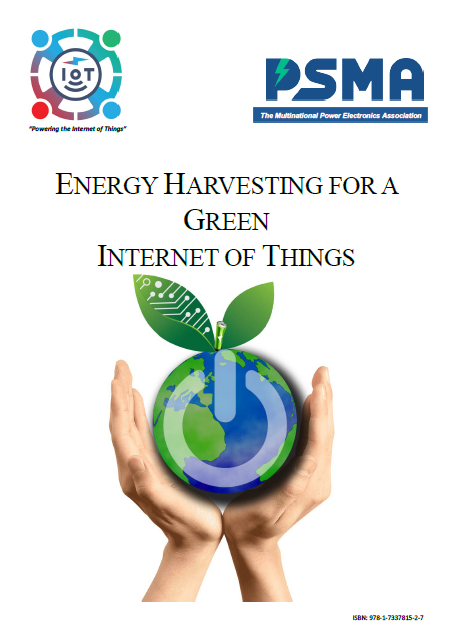
The ubiquitous nature of energy autonomous microsystems, which are easy to install and simple to connect to a network, make them attractive in the rapidly growing Internet of Things (IoT) ecosystem. The growing energy consumption of the IoT infrastructure is becoming more and more visible and impactful. Energy harvesting describes the conversion of ambient energy into electricity, enabling green power supply of IoT key components such as autonomous sensor nodes. Energy harvesting could lead to a lower CO2 footprint of future IoT devices by adapting environmentally-friendly materials and reducing cabling and primary battery usage.
The key findings in the White Paper are as follows:
- energy harvesting is a key enabling technology for the green Internet of Things;
- this potential is demonstrated with several use-case studies;
- industrial adoption is reluctant despite positive costs-benefits and their life-cycle impacts;
- massive future deployment requires a concerted strategy in research and technology accompanied by disruptive industrial product developments and innovations.
The paper is available at no cost on the PSMA website Energy Harvesting Technical Forum at https://www.psma.com/technical-forums/energy-harvesting/whitepaper.
About PSMA:
PSMA is a non-profit professional organization with the objective of enhancing the stature and reputation of its members and their products, and improvement of their technological power sources knowledge. Its aim is to educate the entire electronics industry, academia, government, and industry agencies as to the applications and importance of all types of power sources and conversion devices.
The Energy Harvesting Committee is one of 12 committees within PSMA that focuses on particular power electronics technologies (from materials to devices and systems) and/or applications. The committee is planning the 2022 EnerHarv Workshop at NCSU in Raleigh, NC. For more information, visit www.enerharv.com
 Powerbox, one of Europe’s largest power supply companies, and for more than four decades a leading force in optimizing power solutions for demanding applications, announces it has consolidated its Swedish operations to a new facility located at Hägersten, South of Stockholm.
Powerbox, one of Europe’s largest power supply companies, and for more than four decades a leading force in optimizing power solutions for demanding applications, announces it has consolidated its Swedish operations to a new facility located at Hägersten, South of Stockholm.IPC in cooperation with PSMA is developing a new standard on the "Specification for Firmware Design and Test Requirements for Power Subsystem Assemblies". The proposal for this standard is based on the "PSMA Power Supply Software/Firmware Reliability Improvement Report." This report was written as part of a special project sponsored by the PSMA Reliability Committee.
We are seeking members from PSMA and the greater power electronics community to join this effort. Topics that are proposed to be a part of this standard include:
- Firmware design requirements including basic function, error handling, reliability, performance, etc. This will cover basic architecture and design around that architecture as well as upgradeability. A section to be included on understanding intended application environment.
- Firmware test/qualification requirements to verify that the design elements are operating at minimum level. Sections would include testing to verify all critical design and application requirements. It will address exerciser code, unit test and integration topics.
- Firmware security for protecting against internal threats and external attack. Sections to include library verification, access to source code, physical security, plugging into the IT/OT network, user logging and tracking, virus mitigation, external access security, update/upgrade security, etc.
We are in the process of forming the committee to start drafting this standard and are seeking members interested participating and/or leading the development of various sections to be included in the document. This is intended to be a requirements standard that can be used to define expectations for firmware design, test, and security in power assemblies and could be considered the start of a family of standards that complement the current IPC-9592B standard. Please contact any of the following people if interested.
Jerry Strunk (Jerry.strunk@us.abb.com)
Eric Swenson (ebswensn@us.ibm.com)
Brian Zahnstecher (bz@powerrox.com)
Thank you for your consideration. We look forward to hearing from you.
![]() riends of PSMA introduces readers to organizations that PSMA has cooperative relationship with to better serve our respective memberships and the international power electronics industry. If you have suggestions on other industry organizations to consider or ways that we can improve our current relationship with other industry associations, we would be delighted to hear from you.
riends of PSMA introduces readers to organizations that PSMA has cooperative relationship with to better serve our respective memberships and the international power electronics industry. If you have suggestions on other industry organizations to consider or ways that we can improve our current relationship with other industry associations, we would be delighted to hear from you.
In this article we introduce you to the The European Power Supply Manufacturers' Association (EPSMA).
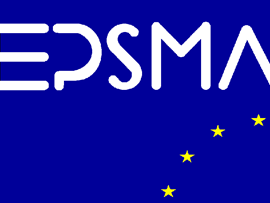 In the year 2020, the EPSMA celebrated the 25th anniversary of its founding. It was formed from a group of European power supply manufacturers who were participating in a continuous power market survey, organized by IMS, now IHS Markit. The data from the companies was anonymized, but the group made connections with each other and saw an advantage in forming an association for their mutual benefit. IHS agreed to act as the secretariat for the group and it was formally registered as a 'European Economic Interest Group' (EEIG) in 2002. This status allowed companies who were often competitors to meet as a 'trade association' to represent the interests of their members to national bodies and to promote European power supply manufacturers overall. To be able to monitor and influence European standards relating to power supplies, the EPSMA became a CENELEC liaison organization, affiliated with technical committee TC 22X, which is responsible for standards relating to power converters. Some EPSMA members are in fact already members of TC 22X. IHS relinquished the secretariat service in 2015 and the function is now within the EPSMA organization.
In the year 2020, the EPSMA celebrated the 25th anniversary of its founding. It was formed from a group of European power supply manufacturers who were participating in a continuous power market survey, organized by IMS, now IHS Markit. The data from the companies was anonymized, but the group made connections with each other and saw an advantage in forming an association for their mutual benefit. IHS agreed to act as the secretariat for the group and it was formally registered as a 'European Economic Interest Group' (EEIG) in 2002. This status allowed companies who were often competitors to meet as a 'trade association' to represent the interests of their members to national bodies and to promote European power supply manufacturers overall. To be able to monitor and influence European standards relating to power supplies, the EPSMA became a CENELEC liaison organization, affiliated with technical committee TC 22X, which is responsible for standards relating to power converters. Some EPSMA members are in fact already members of TC 22X. IHS relinquished the secretariat service in 2015 and the function is now within the EPSMA organization.
Some of the initial work by the EPSMA was related to the protection of the European industry from product and component 'dumping' from the far east which was creating an unfair market with items that were not necessarily meeting acceptable quality standards. The EPSMA identified related products and informed the authorities. Another area of work was an effort to influence and mitigate the effects of the original power factor correction (PFC) requirements, that had been imposed on the industry with little warning.
EPSMA membership originally was limited to power companies headquartered in Europe, but with the globalization of the industry, this was relaxed and any power supply manufacturer or supplier to the industry can join as a full member if they have at least one full-time employee in Europe. There is also an affiliate membership category which typically includes educational establishments such as universities. The EPSMA is controlled by a management committee of around twelve members which meets four times each year, either in person or by teleconference. There is also a technical committee (TC) consisting of experts from member companies, which meets to discuss technical developments in the industry and inform the membership. The TC also generates in-depth technical documents, typically related to standards, for the guidance of members. These documents are available for non-members to purchase. The most popular over time has been the EPSMA's analysis of the PFC or 'harmonic emissions' standard with specific guidance on how to comply. This was updated in 2018 to include the most recent requirements. Other documents published include guidance for compliance with medical, rail, telecomms, DIN rail and hazardous location safety standards.
The TC has also published papers on the implications of the RoHS, WEEE directives and general power supply design guides on 'Accurate Efficiency Measurements', 'Lifetime Prediction', 'Reliability Prediction' and 'Embedded Software verification and Validation'. Some of these documents are free to download for non-members and a full list, including abstracts of 'members only' documents are available at www.epsma.org/technical-publications. The current work by the TC is focused on generating a guidance document about 'Over-voltage Categories' and their implications on power supply design.
As of today, the EPSMA has around 25 members including all of the main European power supply manufacturers. Six universities are affiliate members as is one of the European test houses. Four of the founding members remain active in the association and new members join at a steady rate. The website www.epsma.org is the portal for information on the activities of the EPSMA with member news and product press releases, information about latest publications, member job vacancies and a quarterly newsletter. There are links on the website to industry resources and indeed to the PSMA. For more information about membership or any other aspect of the EPSMA, please contact: secretariat@epsma.org.
Provided by Paul Lee, EPSMA Secretariat
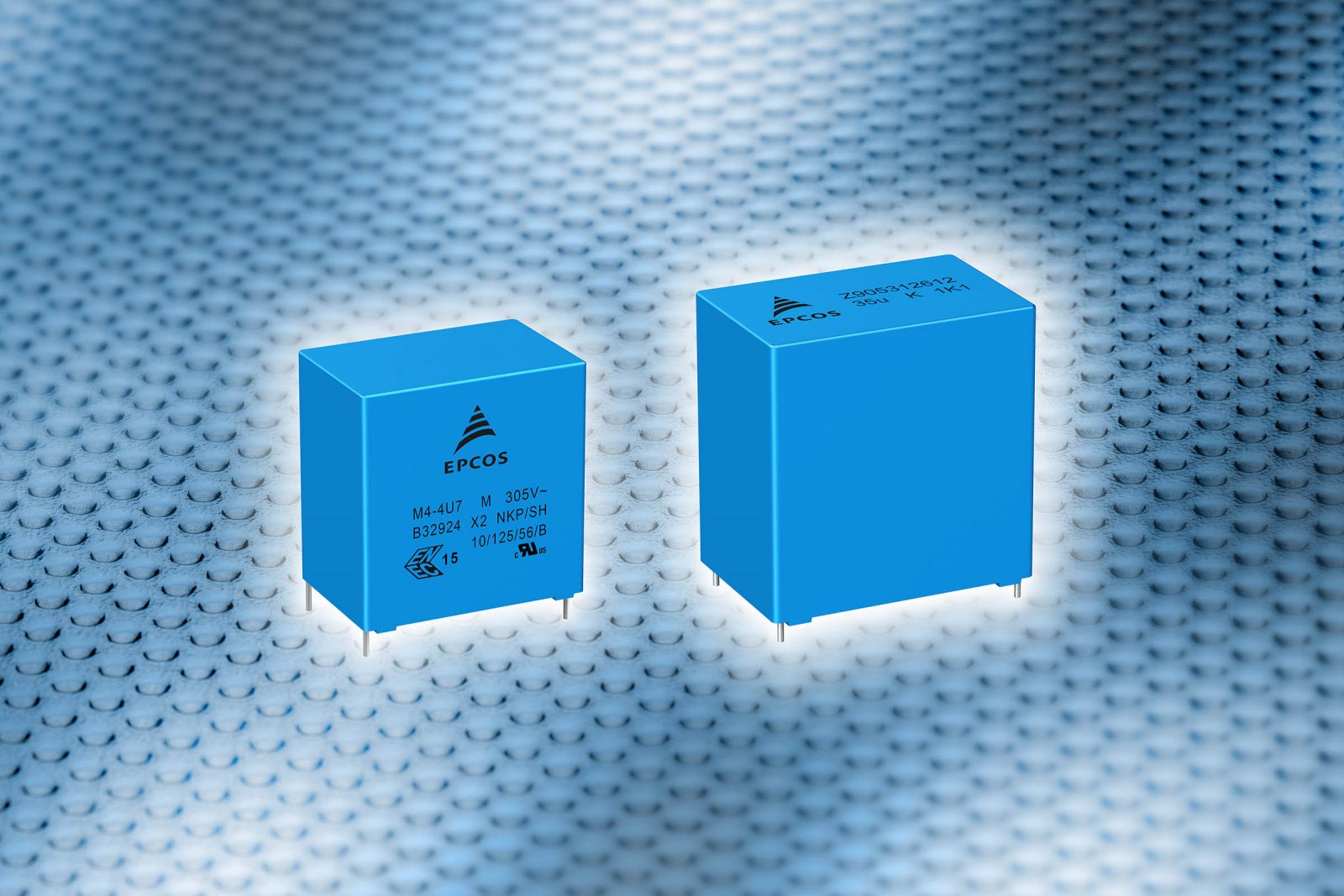 TDK Corporation presents the new, powerful and intuitive CLARA tool (Capacitor Life And Rating Application) for calculating and selecting EPCOS and TDK film capacitors for PCB mounting. The tool offers a versatile parametric search functionality. This includes a search for capacitance, voltage range as well as for rated voltage, RMS and peak current, temperature, maximum dimensions and volume, approvals, reference standards as well as typical applications.
TDK Corporation presents the new, powerful and intuitive CLARA tool (Capacitor Life And Rating Application) for calculating and selecting EPCOS and TDK film capacitors for PCB mounting. The tool offers a versatile parametric search functionality. This includes a search for capacitance, voltage range as well as for rated voltage, RMS and peak current, temperature, maximum dimensions and volume, approvals, reference standards as well as typical applications.
By clicking just once, the performance of up to four capacitors can be simulated under application conditions. This is displayed in a clear table, which may include the following parameters, for example: operating temperature, DC voltage, AC voltage, peak current and expected service life. Furthermore, safety tolerances are specified allowing developers to adjust the configuration in line with their specific requirements. Moreover, a warning is issued if the permitted capacitor parameters are exceeded.
Application conditions, including personal notes, can be stored for future use. STEP files and SPICE simulation data are available for the majority of capacitors. CLARA is linked to the TDK Product Center. The selected capacitors can be easily ordered from there by means of service distributors. The new tool is available for developers at:
www.tdk-electronics.tdk.com/
The Energy Harvesting White Paper Committee is preparing a White Paper on Energy Harvesting elucidating the enormous opportunities of the technology despite a reluctant adoption in some industries.
Although Energy Harvesting methods and devices have reached a credible state-of-art, relatively few devices are currently commercially available and off-the-shelf harvester solutions often require an extensive adaption to the envisaged application. A synopsis of typical energy sources, state-of-the-art materials and transducer technologies for efficient energy conversion, storage and management encompasses a wide range of successful research results. But developing power supplies for actual applications reveals their strong dependence on application-specific installation requirements, power demands and environmental conditions resulting in a less extensive portfolio of successful system integrations.
The industrial challenges for a massive spread of autonomous sensor systems are manifold and diverse. Reliability issues, obsolescence management and supply chains need to be analysed for commercial use in critical applications. On this front, the gap between currently available solutions and use-case scenarios is analysed from the perspective of the user. The white paper then proceeds to identify the key advantages of energy autonomy in environmental, reliability, sustainability and financial terms.
Energy harvesting could lead to a lower CO2 footprint of future IoT devices by adopting environmentally friendly materials and reducing cabling as well as battery replacement. Further research and development is evidently needed to achieve a technology readiness levels acceptable for the industry. From this discussion, this white paper will propose a future research and innovation strategy for industry-ready green microscale IoT devices, as a key and seminal initiative to provide useful information to the different stakeholders involved, encourage more interaction between them and deliver industry ready solutions.
Contact and further information: Thomas Becker, Thobecore (email: thobecore@outlook.de), Michalis Kiziroglou, Imperial College London (email: m.kiziroglou@imperial.ac.uk)
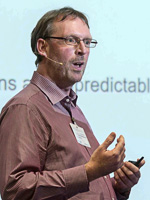  l l |
Provided by Thomas Becker (left) and Michalis Kiziroglou (right)
PSMA Energy Harvesting White Paper Committee Co-Chairs
|
The PSMA Strategic Agenda for the 90s included:
As mentioned in my article in the last issue of the Update "In the Beginning", in 1990 PSMA joined IEEE IAS and PELS as a co-sponsor of APEC. I would opine that "1991 was a turning point for PSMA and APEC." APEC 91, the first conference sponsored by the 3 organizations, was led, as continues today, by a team of volunteers representing the 3 sponsors, including General Chair Chuck Harm, PELS; Program chair Dr. Tom Jahns, IAS; and Exhibits Chair Dave Kemp, PSMA. The conference was a huge success, though not without its challenges. The Gulf War had an impact with a reduction in our projected international attendance. Our initial concerns were confirmed when David Fields of TDK-Lambda U.K. a Plenary Session speaker, cancelled. His presentation was to address the world market for power supplies. I was asked to take his slot and presented "Global Power Supply Implication...the squeeze is on." I also led an evening rap session titled "Are Power Supply Manufacturers a Band of Liars and Thieves?" During his Keynote Speech, W. J. Warwick, President of AT&T Microelectronics, mentioned the topic of my rap session, saying "he will need to know if it's safe to go back to the office." Some notable moments from APEC social events in the 1990s:
|
|||||||||||||||
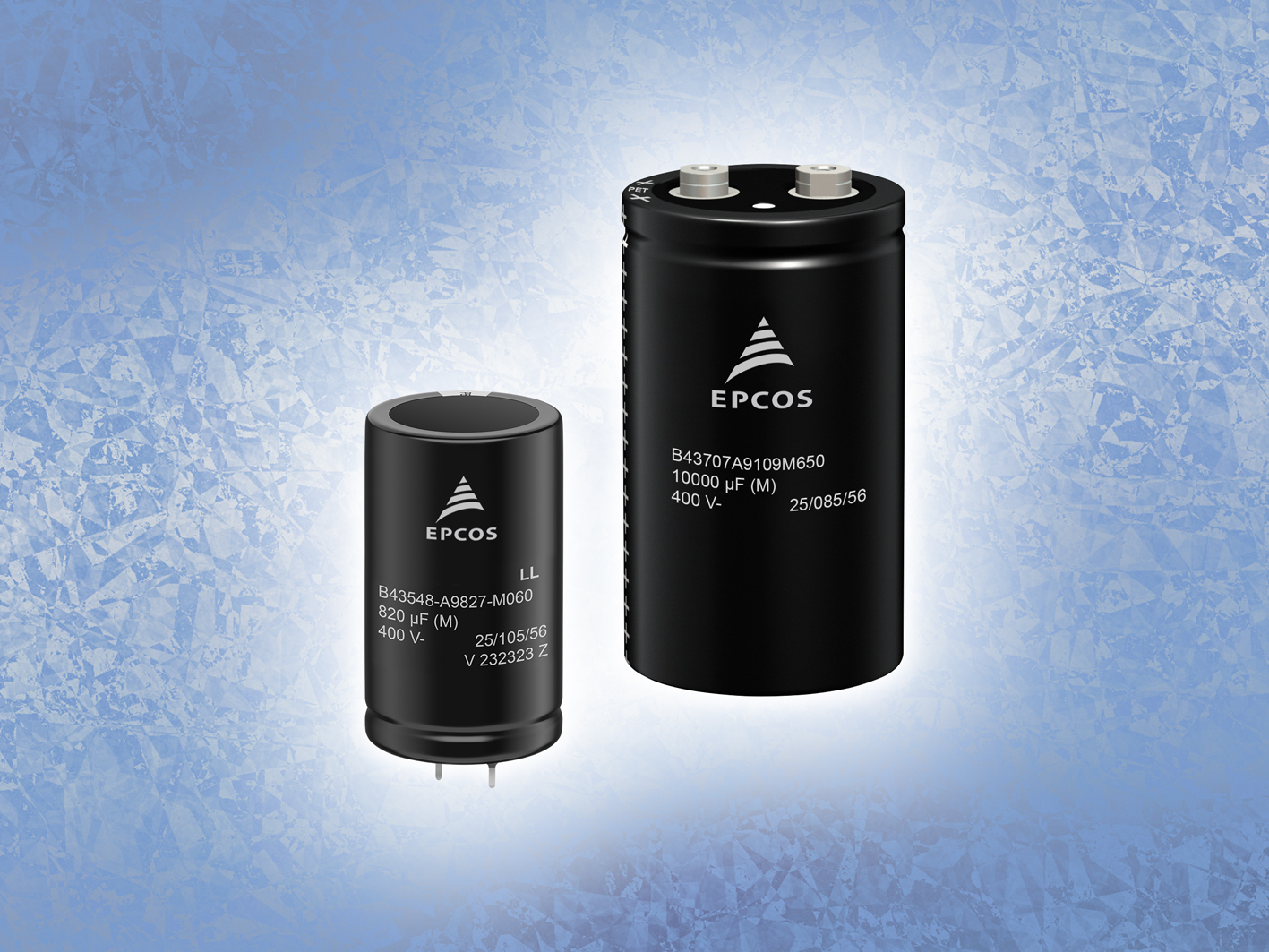 TDK Corporation (TSE:6762) presents the fully revised version 4.0 of the tried and tested Online AlCap Useful Life Calculation Tool for EPCOS aluminum electrolytic capacitors. The tool covers all new high-voltage capacitors (>150 V DC) with screw, snap-in and solder pin connections. These DC link capacitors are particularly suitable for new designs of converters for industrial applications, such as photovoltaics and wind power generation, as well as uninterruptible power supplies.
TDK Corporation (TSE:6762) presents the fully revised version 4.0 of the tried and tested Online AlCap Useful Life Calculation Tool for EPCOS aluminum electrolytic capacitors. The tool covers all new high-voltage capacitors (>150 V DC) with screw, snap-in and solder pin connections. These DC link capacitors are particularly suitable for new designs of converters for industrial applications, such as photovoltaics and wind power generation, as well as uninterruptible power supplies.
The AlCap tool enables up to 15 load profiles to be simultaneously entered, calculated and, if so desired, stored for later use. This powerful function allows applications to be developed both with single capacitors and capacitor banks. Furthermore, the tool can perform on a customer-specific basis calculation. This merely requires the CSC code specified in the respective data sheet to be entered.
Once all relevant values have been entered, in addition to the useful life of the capacitors under defined load conditions, the user also obtains data regarding the hot-spot temperature, power dissipation and much more. Coupled with its useful lifecycle under defined load conditions, the AlCap tool provides industrial designers a solution that meets the needs of their demanding applications.
For more information visit http://www.tdk-electronics.tdk.com/
.jpg) TDK Corporation presents a new, user-friendly tool to help users select the right PTC inrush current limiters (ICL) for a range of different power supply and converter topologies. The intuitive tool is available online and does not need to be downloaded. The selection process is divided into four stages: After specifying the circuit structure and the capacitor bank's total capacitance, the developer must then enter the charging voltage and the maximum ambient temperature of the PTC inrush current limiter. After this has been done, the tool displays a list of suitable components for the user, and if a parallel connection is required, the number of components required is also shown. The most important key figures are also shown, as well as links to service distributors that sell the PTC ICLs.
TDK Corporation presents a new, user-friendly tool to help users select the right PTC inrush current limiters (ICL) for a range of different power supply and converter topologies. The intuitive tool is available online and does not need to be downloaded. The selection process is divided into four stages: After specifying the circuit structure and the capacitor bank's total capacitance, the developer must then enter the charging voltage and the maximum ambient temperature of the PTC inrush current limiter. After this has been done, the tool displays a list of suitable components for the user, and if a parallel connection is required, the number of components required is also shown. The most important key figures are also shown, as well as links to service distributors that sell the PTC ICLs.
WOW!. Happy 35th Anniversary PSMA.
In the 1970s and early 80s the power electronics industry encountered a huge leap in power supply design technology driven in part by the introduction by Apple and IBM of personal computers. Up until that time, the technology primarily used was large and heavy linear technology power conversion, "boat anchors" manufactured in two car garages as the expression went. During that time, the industry also began to face the challenge of transitioning to bi-polar and high frequency MOSFET designs that would create more efficient, smaller, and lighter products. This encouraged a group of design engineers and marketing leaders to explore creating a new industry group to focus on educating themselves and their customers as the industry began to implement and accept these evolving power technologies. At that time Electro, PowerCon and Westcon were the trade shows and conventions focusing on power electronics.
On Nov 15, 1985, the Power Sources Manufacturers Association, PSMA, was founded as a 501 C (6) nonprofit industry association. Three months later, in Feb of 1986, the first Board of Directors were elected at a meeting held in Dallas, TX. Tim Parrott served as President and Ron Koslow was PSMA's first Chairman. The Bylaws identified three levels of membership – Regular (Manufacturers of power sources and conversion equipment), Associate (Users of power sources and conversion equipment, or manufacturers of components designed for incorporation into power sources and conversion equipment) and Affiliate (Organizations involved in the power industry, including Manufacturer's Representatives, Distributors, Advertising, Marketing, Consulting, Publications).
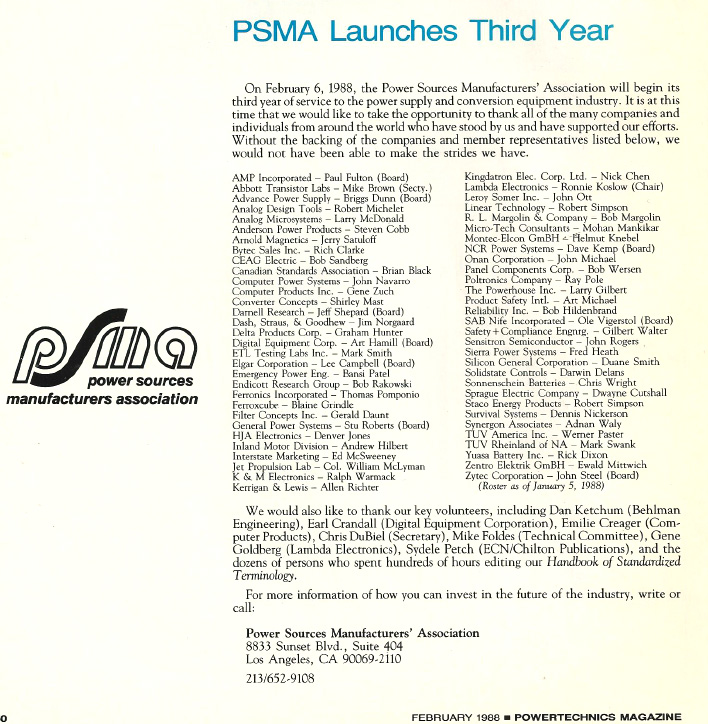 PSMA launches third year ( Click to enlarge ) |
To establish early credibility, the Board decided to create a "Handbook of Standardized Terminology for the Power Sources Industry". Michael Foldes led the Technical Committee that also included Dan Ketchum, Earl Crandall, Emilie Creagar, Chris DuBiel, Gene Goldberg, Sydele Petch and myself. This was before email and online collaboration tools; Michael sent us each an 8" disc for making our corrections suggestions and additions
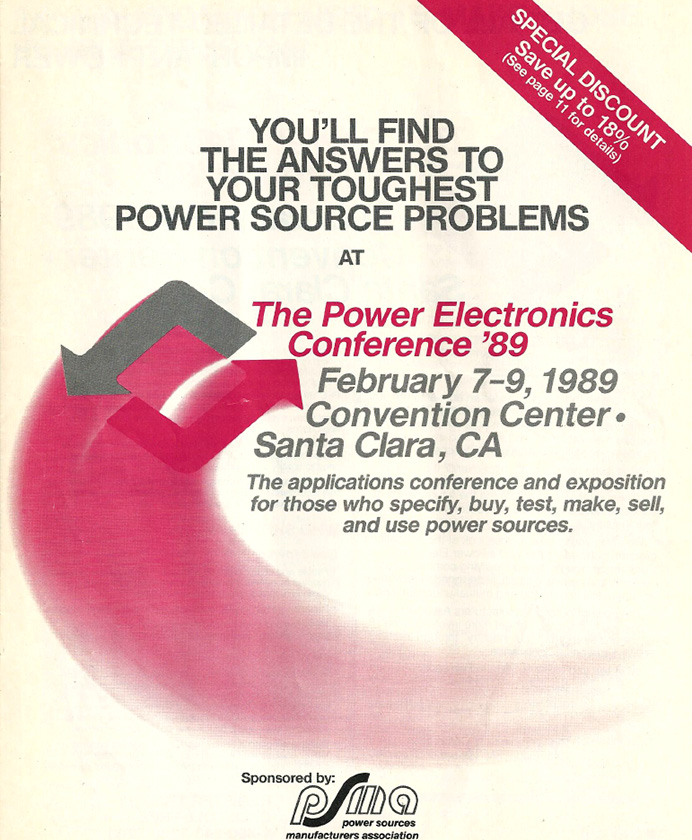 PEC 1989 ( Click to enlarge ) |
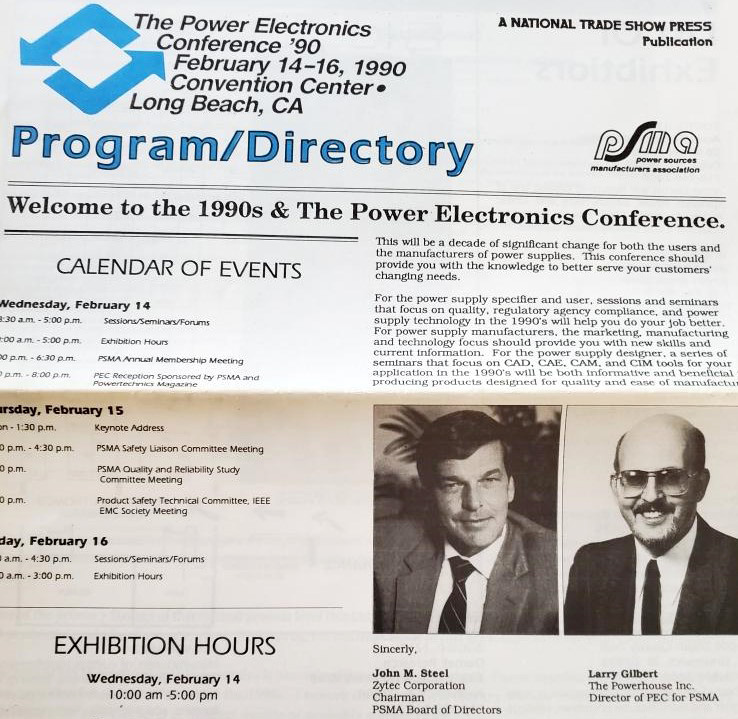 PEC 1990 ( Click to enlarge ) |
To provide industry exposure PSMA co-sponsored the Power Electronics Conference, PEC, in San Jose in Feb of 1989. PSMA Chairman Art Hamill said, "we believe there is a need for an industry-wide forum which brings together the component suppliers, manufacturers and users of power sources and suppliers. That conference and exposition offered six half day Professional Education Seminars and nine Technical Sessions. One year later, in February 1990, PEC was held at the Long Beach California Convention Center and featured three tracks of "Issue Forums" to discuss industry trends.
To create "deliverables" a Research and Development Committee was formed, led by Donald Staffiere of Digital Equipment and John Woodard of ITT Power Systems, with members representing suppliers, users and university members. In 1990, the committee completed its first report to the Association on the status of R&D in the world and presented the results at the PSMA Annual Convention held in Long Beach, CA in conjunction with PEC. This report evolved over time into the current PSMA Power Technology Roadmap.
In March of 1990, John Steel represented PSMA at an IEEE PELS Power Electronics Retreat with leaders from industry and academia. Interestingly, the meeting minutes contained a sidebar that read, "This was the high energy point of the day. Even though we didn't quite know what that meant, we liked the words 'GREEN ENERGY".
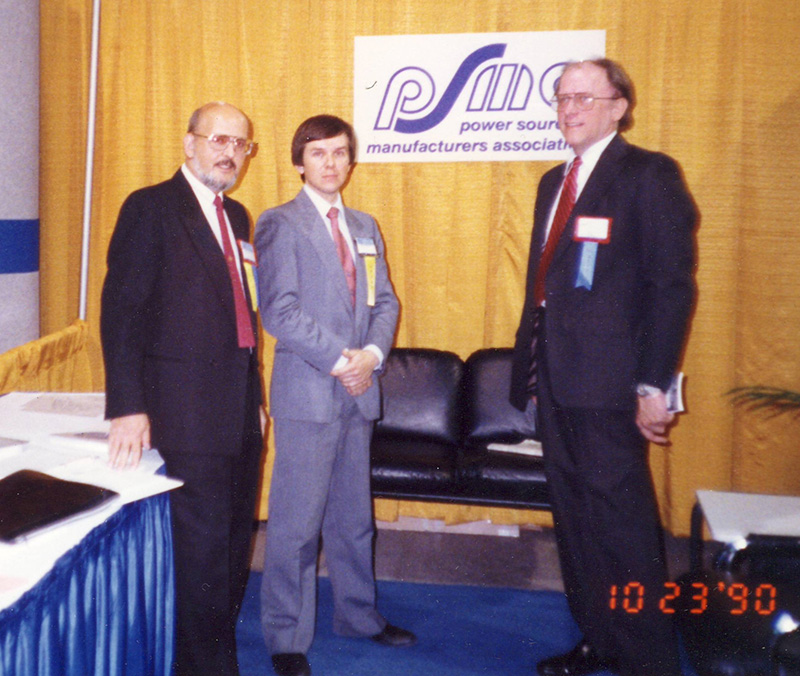 Larry Gilbert, John Rowbottom and Dave Kemp at the PSMA booth at the 1990 Canadian High Technology Show ( Click to enlarge ) |
Expanding PSMA's exposure, later that year we participated at the Canadian High Technology Show in Toronto. We conducted a Customer-Supplier partnership forum, Norm Berkowitz of Computer Products and myself representing the US, and Glen Belland (Electronic Craftsman) and John Rowbottom (NCR) representing Canada.
After the 1990 PEC and APEC conferences, a group representing PSMA negotiated with representatives of PELS and IAS to become the third financial and technical sponsor of APEC (Applied Power Electronics Conference). The Sponsor Agreement on the Continuing Operation of APEC was written by Bob White and the signers were John M. Steel, PSMA Chairman, Ronald M. Jackson, President IEEE Industrial Applications Society (IAS), and Thomas G. Wilson, President IEEE Power Electronics Society (PELS). In Jan of 1991, Dave Kemp and I were appointed Co-chairs of the APEC Technical Program Committee.
There are so many more names that deserve a shout out in the first five years of PSMA. A partial list of the PSMA family at that time includes: Norm Berkowitz, Mike Brown, Lee Campbell, Frank Cathell, Earl Crandall, Emilie Creagar, Chris DuBiel, Mike Foldes, Paul Fulton, Gene Goldberg, Art Hamill, Albert Himy, Dave Kemp, Dan Ketchum, Jim Kimball, Ron Koslow, John Lombardi, Sr., Doug McIlvoy, Mohan Mankikar, Chuck Mullett, Tim Parrott, Sydele Petch, Stu Roberts, Jeff Shepard, Don Staffiere, John Steel, David Thompson, Dean Venable, Ole Vigerstol, Bob White and John Woodard.
We hope to include another article on the early history of PSMA in a future issue of the UPDATE
|
Provided by Larry Gilbert,
|
 |
Over the past five years, the PSMA Magnetics Committee has sponsored five Special Projects to better understand the flux propagation in ferrites and the reasons why the performance of large inductor cores performed so poorly compared to the expectations based on published specifications from the suppliers.
The first three projects - PSMA -Dartmouth Core Loss studies- were undertaken by Dartmouth under the leadership of Professor Charles Sullivan and the results are available on the Magnetics Forum on the PSMA web site. Based on some of the insights from these projects formed the basis for the 2 most recent projects – PSMA- SMA Core Loss Studies Phase 1 and Phase 2.
The last two Core Loss Studies are now complete, and this article highlights some of the most interesting findings. This article is not as comprehensive as the reports, and the reader is encouraged to read the full reports on the PSMA web site for more information.
PSMA–SMA Core Loss Study Collaboration
SMA Magnetics was interested in why large inductor cores performed so poorly compared to expectations based upon published specifications. At the the same time, PSMA was interested in flux propagation in ferrites and why the performance factor B*f was lower and peaked at a lower frequency for larger cores.
Charlie Sullivan (Dartmouth) recognized that there was significant overlap in these interests and arranged an introduction which resulted in the Phase I PSMA-SMA core Loss study. The findings of the Phase I study were so intriguing that a Phase II study followed, which built upon the data from Phase I.
The Phase I and Phase II test reports can be found on the PSMA website Core Loss Studies tab of the Magnetics Forum. The Phase I report is publicly available; Phase II is currently only available to PSMA members, and will be publicly available in late 2021.
PSMA - SMA special project – Phase I
The purpose of the Phase I PSMA-SMA Core Loss projects was to study the flux distribution within ferrite cores while operating. The concept is that a small area internal to the core can be enclosed by a test winding inserted into drilled holes. The voltage on the test windings shows the dφ/dt of the flux.
Initially, eight specially machined cores, two each of four materials, were made by Fair-Rite. Three holes were drilled into each core so that flux in the innermost 1/9th of the core area could be compared to the excitation. These cores were shipped to SMA for study.
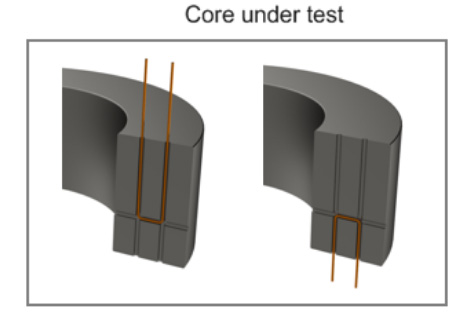 |
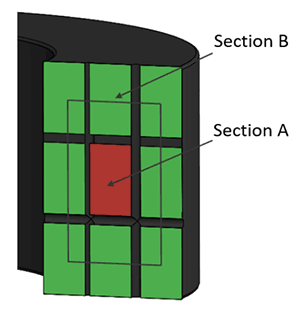 |
Although the original scope was to test these eight cores, SMA drilled seven more 50 mm cores of various materials to provide a larger sample.
A surprising result for some of the cores was that the flux density in the center of the core was much higher than the average flux density, peaking at just over 2.5 times. Further, it had a large leading phase.
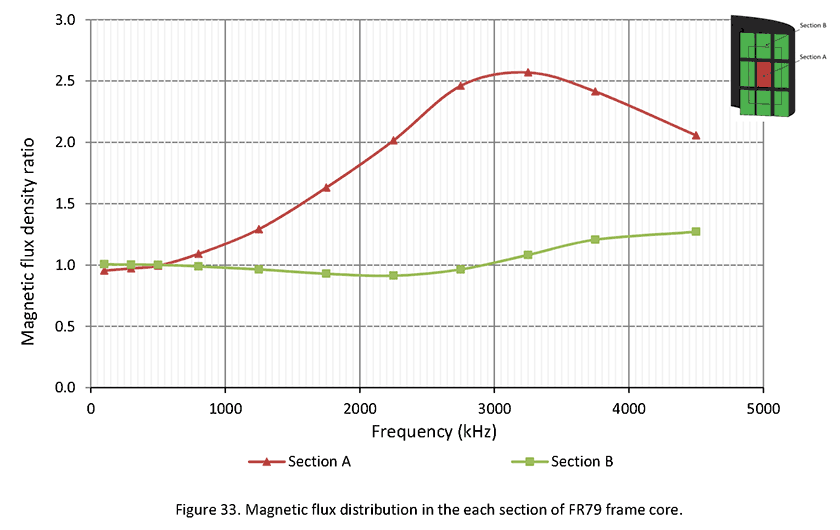 |
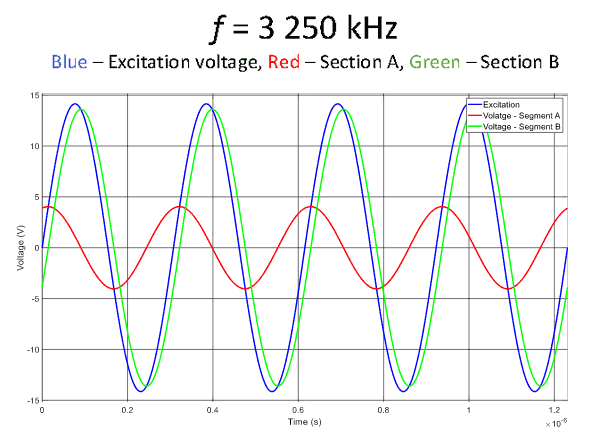 |
PSMA - SMA special project – Phase II
Phase II was a larger study comprising five parts:
1. Large core testing–flux propagation in ferrites
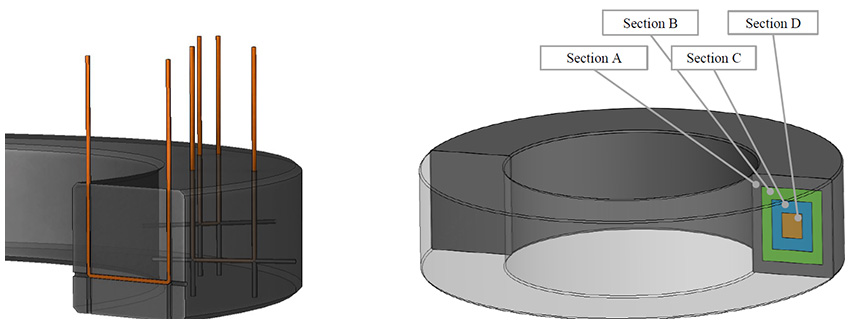
Several large cores were drilled with nine holes so that three sets of wires enclosed progressively smaller internal areas. In this way, the flux and flux density can be measured in three shells and the center for comparison with the excitation voltage.
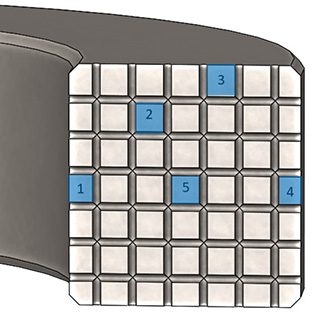 |
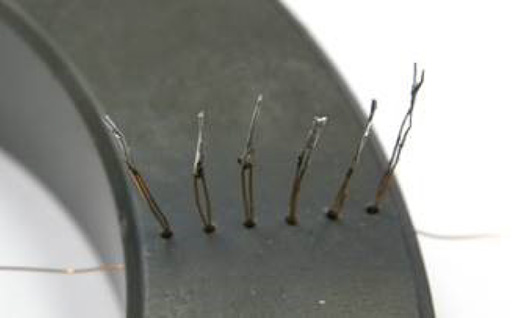 |
Two other large cores were drilled so that the voltage can be measured around any of 49 segments. Each segment is the same size, 1/49 of the total, so one-to-one comparisons could be made.
2. Core power loss comparison with different sized cores of the same material.
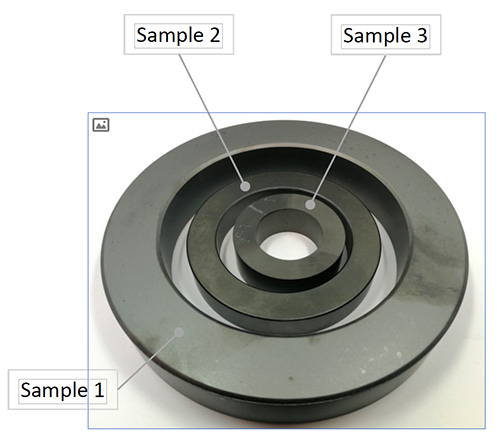 |
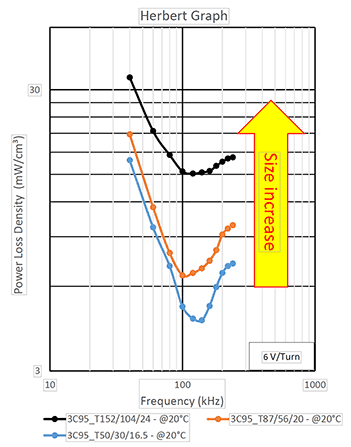 |
Large cores of the same material were found to have significantly higher losses when compared on the basis of mw/cm3. This suggests that core loss for different core sizes cannot be calculated based on material specifications, which are usually taken using a "standard" core of about 2.5 cm outside diameter.
3. Core shape effect on power loss
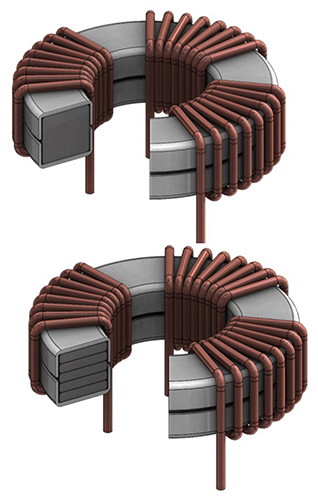 |
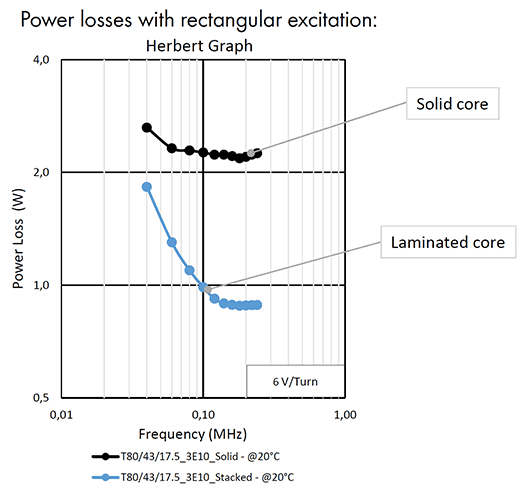 |
Core losses were significantly lower for a core that was laminated. The second core above has the same area, volume and weight as the first core, but it comprises 5 thinner laminations.
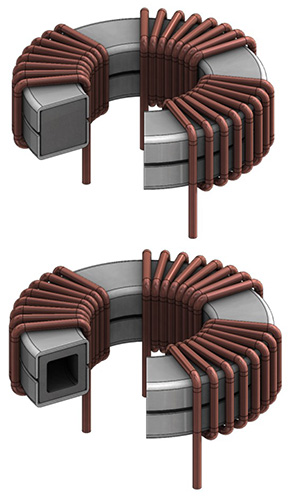 |
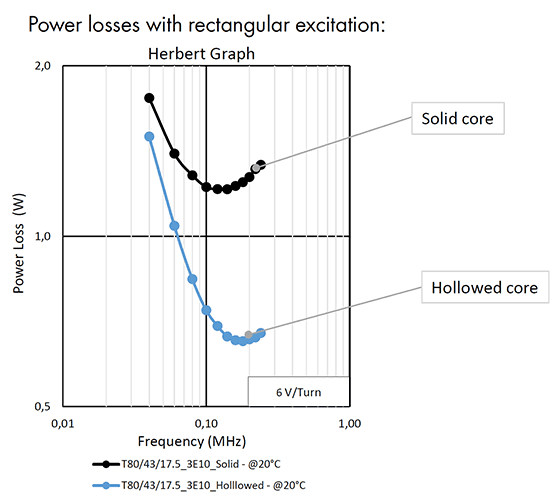 |
Core losses were significantly lower for a core that was hollowed out. The second core has the same ID, OD and height as the first core. Its area, volume and weight are lower, so higher losses may be expected at very low frequencies.
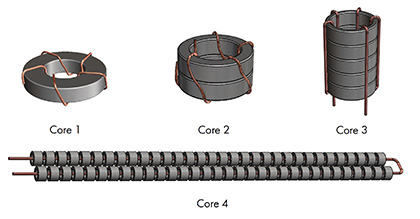 |
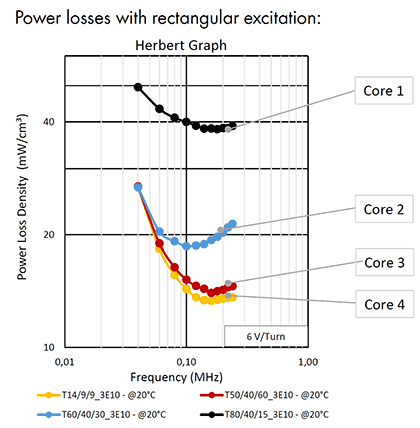 |
The four cores above all are the same weight and volume. Cores 1, 2 and 3 have the same ID but cores 2 and 3 are stacked and have the same area, volume and weight as core 1. Core 4 has five times the area because it is wound with only one turn, but it has the same volume and weight as the others.
The inductances of the four cores are very close to the same value, as are their other electrical properties except the core loss. The multi-core stacks have significantly lower core loss.
4. Ferrites electrical properties
The electrical parameters (permittivity, permeability, and conductivity) of various ferrites were measured. These must be known accurately to model the core performance successfully.
As an example, Finite Element Analysis (FAE) did not model the observed flux distribution very well using traditional parameters from data sheets. Once the analysis was modified to use accurate parameters, the analysis was greatly improved.
5. Rectangular wave core loss tester
Part of the Phase II core loss program was developing an improved full-bridge rectangular wave driver for core loss testing. The wave shape is determined by an arbitrary waveform generator under software control. The voltage is controlled by a programmable power supply. The time, voltage and current are measured using a high accuracy digital sampling oscilloscope and the parameters are exported to a spreadsheet for post processing and storage. All of the software operations are written in Python.
PSMA Magnetics Committee
In addition to sponsoring these five core loss studies, the PSMA Magnetics Committee continues to be very active. They have organized 5 "Power Magnetics @ High Frequency" workshops in addition to conducting very successful APEC Industry Sessions each year. They also presented two educational webinars as part of the "PSMA Basics of Magnetics for Switching Power Webinar Series" in early 2020. The committee meets about once a month by webconference and anyone interested is invited to participate. Contact the PSMA office at power@psma.com for more information.
Provided by Ed Herbert, PSMA Magnetics Committee Co-Chair
iNEMI Publishes Best Practices for Protecting the Reliability and Integrity of Electronic Equipment when Disinfecting for COVID-19
The International Electronics Manufacturing Initiative (iNEMI) today announced publication of “Recommended Best Practices for Protecting the Reliability and Integrity of Electronic Products and Assemblies when Disinfecting for SARSCoV- 2 (COVID-19).”
Developed by a team of experts from across the member organizations of the International Electronics Manufacturing Initiative (iNEMI), this document provides guidance on how to mitigate the possible detrimental impact of disinfecting procedures on electronic equipment and assemblies. Groups such as the U.S. EPA, CDC and the World Health Organization (WHO) have published general guidelines regarding cleaning and disinfecting for COVID-19, but none of these specifically address the impact of disinfectants and their application methods on electronic equipment and assemblies. Many commonly recommended disinfection substances and/or application methods could potentially cause failures in electronic equipment.
To develop these best practices, the iNEMI team reviewed key industry, government and technical sources. They also assessed the chemicals included in the U.S. EPA List N: Disinfectants for Use Against SARS-CoV-2 (COVID-19) and common application methods, identifying those substances that minimize the risk of negative impact on electronic equipment when applied in an appropriate manner.
“With the COVID-19 crisis, several of our members have contacted iNEMI for guidance on how to mitigate the possible detrimental impact of disinfecting procedures on electronic equipment and assemblies,” said Marc Benowitz, iNEMI CEO. “There are guidelines from groups such as the U.S. EPA, CDC and the World Health Organization (WHO) regarding cleaning and disinfecting for COVID-19, but none of these address the impact of disinfectants and their application methods on electronic equipment and assemblies.”
“Many commonly recommended disinfection substances and/or application methods could potentially cause failures in electronic equipment if the internal electronics were inadvertently exposed to them,” continued Benowitz. “This is an obvious concern for electronics manufacturers who are wanting to ensure the safety of their employees, supply chain partners and customers, while protecting the reliability and integrity of their products.”
Benowitz explains that, in response to this industry need, a team of experts from across iNEMI member organizations reviewed key industry, government and technical sources and assembled a best practices document. The team assessed the chemicals included in the U.S. EPA List N: Disinfectants for Use Against SARS-CoV-2 (COVID-19) and common application methods, identifying those substances that minimize the risk of negative impact on electronic equipment when applied in an appropriate manner.
iNEMI’s best practices are now available to download here.
![]() he Power Sources Manufacturers Association (PSMA) announced the opening of the popular Safety & Compliance Standards Database (SCDB) and Energy Efficiency Regulations Database (EEDB) to the industry with no registration required. You can find information about a Regulation or Standard, its most recent version, revision history, or the latest agency updating work. PSMA has successfully offered the EEDB and SCDB databases to the industry at no charge to the user for several years. Now access is even easier with neither a registration nor log-in required to access all of this industry regulations and standards information.
he Power Sources Manufacturers Association (PSMA) announced the opening of the popular Safety & Compliance Standards Database (SCDB) and Energy Efficiency Regulations Database (EEDB) to the industry with no registration required. You can find information about a Regulation or Standard, its most recent version, revision history, or the latest agency updating work. PSMA has successfully offered the EEDB and SCDB databases to the industry at no charge to the user for several years. Now access is even easier with neither a registration nor log-in required to access all of this industry regulations and standards information.
Every product sold today must meet the requirements of agency regulations, and ultimately standards. Each country or group of countries may have different requirements. It is critical to know the specific ones which your product must comply and the ones requiring compliance within the next two to four years, products you are probably just commencing to design. Since there are numerous regulations and standards, the SCDB and EEDB databases simplify access to the one you need to find. The specifics for each of these databases and how you can easily find them is as follows.
To find the databases, go the PSMA Home Page www.psma.com and follow the links to the database or use the direct links:
- EEDB www.psma.com/technical-forums/energy-management/database
- SCDB www.psma.com/technical-forums/safety/database
The Energy Efficiency Database (EEDB)
PSMA Energy Management Committee sponsors the Energy Efficiency Database, which covers energy efficiency regulations globally for power supplies and motor drives. This database presently tracks on a daily basis 56 agencies and 521 regulations. A significant number of regulations are presently under revision, or revision is complete to become active in 2021/2022.
Figure 1 shows the regulation selection page. You can select a specific agency by application, country or state, or global region. You can also select a regulation by the application. The "Recent or Upcoming Events" section lists all the latest work on all regulations tracked by the database with the most recent date first.
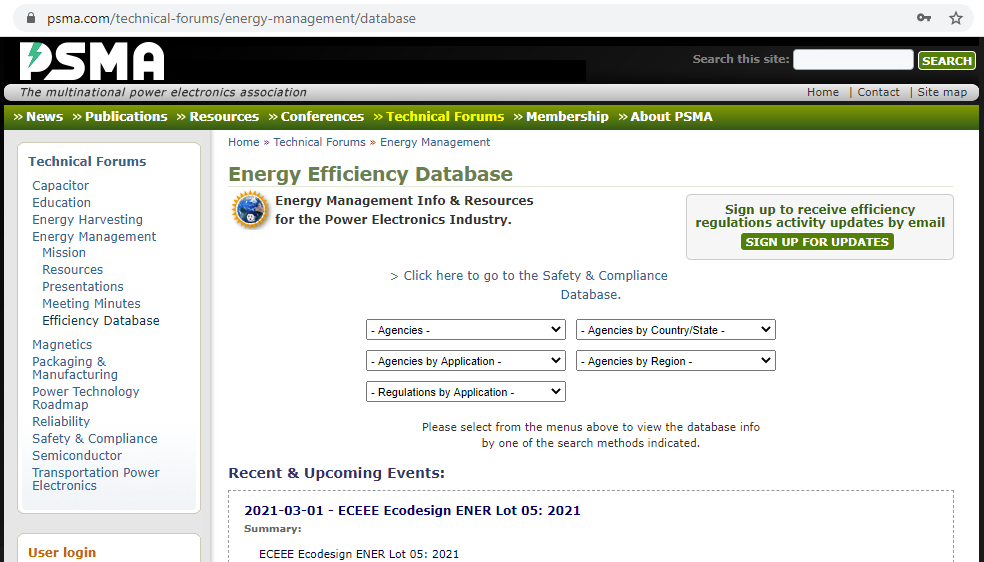 Figure 1 – Energy Efficiency Database Figure 1 – Energy Efficiency Database |
The Safety & Compliance Database (SCDB)
The PSMA Safety & Compliance Committee sponsors the SCDB, which monitors the Power Electronics Standards globally. Presently, this database tracks 778 standards from 50 agencies. The Standards categories include: Product Safety, EMC, Material Toxicity, Environmental, Quality Standard, Performance, Energy Efficiency, and Fundamental Standard.
Figure 2 shows the standard selection page. As with EEDB, you may select a specific agency by application, country or state, or global region. If you have the standard number, you can find it quickly in the bottom selection menu box. The "Recent or Upcoming Events" section lists all the latest work on all standards tracked by the database by the latest date first.
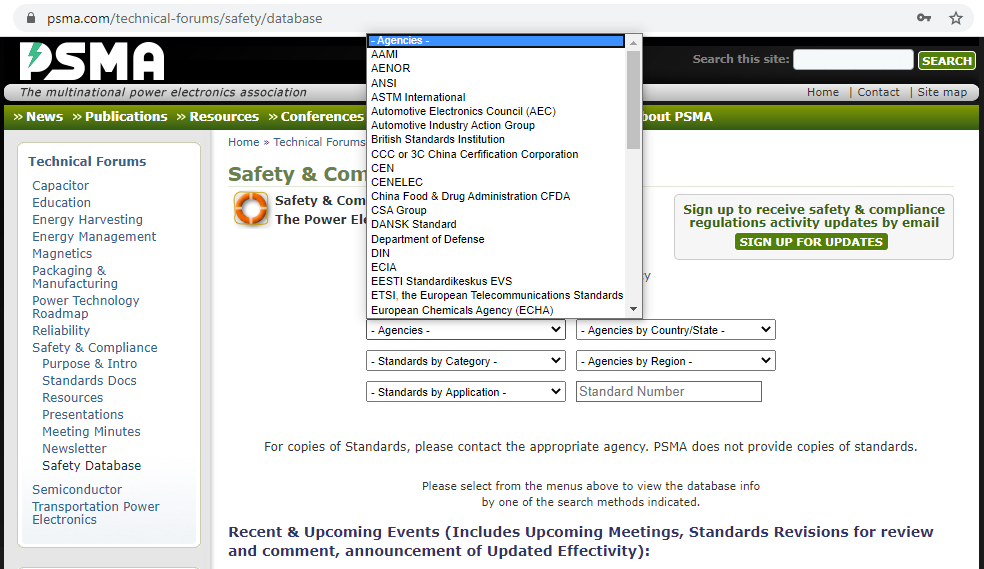 Figure 2 - Safety & Compliance Database Standards Selection Page with Agency Drop List Figure 2 - Safety & Compliance Database Standards Selection Page with Agency Drop List |
And… PSMA Helps You to Stay Up-to-Date Weekly
PSMA further simplifies your access to Regulation updates and Standard updates by offering weekly email announcements containing the latest "Recent or Upcoming Events". This permits you to stay current automatically with present change considerations and work in process on standards and regulations upgrades. There are an average of 30 updates each month from agencies around the globe which the PSMA database team gathers and includes in the weekly email updates. To receive this service, which is provided at no cost to the recipient, you just need to sign up, provide your email address and select the update announcements you want to receive - SCDB, EEDB or both.
The direct links to sign up for email updates to the EEDB data base is https://www.psma.com/webforms/psma-energy-efficiency-database-email-sign.
The direct link to sign up for email updates to the SCDB is https://www.psma.com/webforms/psma-safety-compliance-database-email-sign.
Can you believe that the PSMA & APEC are both 35 years young this year? We can look back on our accomplishments and look forward to what we will achieve in the next decade. That means that there is still time to add to the list of accomplishments. For inspiration, here are some PSMA accomplishments over the years:
- Sponsored APEC (Applied Power Electronics Conference)
- Created and organized various APEC Industry Sessions
- Pioneered APEC Presentation Awards
- Pioneered APEC Student Travel Support
- Pioneered pre- APEC Magnetics & Capacitor Workshops
- Supported and contributed to the International Future Energy Challenge (IFEC)
- Supported Industry input on proposed regulations and standards
- Created the Energy Efficiency and Safety & Compliance Databases, a collection of international standards and regulations.
- Pioneered the Power Technology Roadmaps.
- Pioneered the PwrSoC Workshop, 3D-PEIM Symposium and EnerHarv Workshop
- Published series of reports on trends and advances in power packaging and 3D Power Packaging working with leading universities and technical organizations.
- Republished and made available several out of print industry reference books on magnetics
If your company is not yet a member of PSMA, visit www.psma.com/membership/benefits to learn more about joining PSMA and adding your voice to the almost 200 companies, organizations and educators who for 35 years have worked together to support the mission and initiatives of PSMA and to influence the directions of the Power Sources Industry.
Consider how you can contribute to the many opportunities this year, here are few to get started:
- Contact the Power Technology Roadmap Committee on how you can help the upcoming Power Technology Roadmap 2021.
- Attend an Energy Management Committee meeting to learn how you can stay informed and help shape upcoming regulations from the US Department of Energy in external power supplies.
- Attend a Semiconductor Committee meeting to contribute to the adoption of wide bandgap semiconductors.
- Attend a Transportation Power Electronics Committee meeting to understand the electrification of automobiles and other vehicles.
- Attend a Reliability Committee meeting to address power supply communication bus issues.
- Help lead the Safety and Compliance Committee to discuss emerging electromagnetic compliance and certification testing issues facing designers and meeting customer demands.
If you are interested in any of these opportunities, email power@psma.com.
In addition, all of the PSMA Technical Committees welcome your participation in planning and organizing industry sessions for APEC 2021. Help to raise the bar for APEC 2021 Industry Sessions with new presenters with different views discussing their perspectives. Regardless of whether APEC 2021 is the traditional in person conference or virtual event, people still need to hear new points of view and interact with others to discuss the emerging opportunities in the power electronics industry.
APEC has grown and evolved from the first conference in 1986 with 250 Attendees and 20 Exhibitors while staying true to the original ideals, solidifying its status as the leading conference for practicing power electronics professionals. View the APEC 35th Anniversary presentation to see the conference roots and learn more about the volunteers starting with the original "Gang of 8" who have made APEC so successful!

 First APEC Social (All 250 Attendees)
First APEC Social (All 250 Attendees)
Provided by Ada Cheng and Frank Cirolia
PSMA Marketing Committee members
The Power Sources Manufacturers Association announces a series of webinars as a lead-up to the next edition of the PSMA Power Technology Roadmap (PTR). The webinar series, organized by the PSMA Power Technology Roadmap Committee, will feature invited experts from different fields to offer a range of technological perspectives. In addition to setting the groundwork and providing input for the next PTR, the webinars will give participants access to expert opinions on technology trends and include a question and answer session at the end of each session.
The webinar series will include a number of highly regarded industry and academic experts covering a variety of topics covering components, systems, packaging and applications. The series began on February 20 with a presentation by Ajay Hari of ON Semiconductor "Utilizing WBG Devices in Next Generation Power Converters." Two webinars were held in May, "JEDEC JC-70 Issues Industry First Guidelines for Testing and Evaluating Wide Bandgap Power Devices" presented by Stephanie Watts Butler, Texas Instruments and Peter Friedrichs, Infineon; and "Powering & Retrofitting IoT Devices for Industry 4.0" by Mike Hayes and Peter Haigh, Tyndall National Institute. Future topics include "Ultra-High Density Double-Sided Half-Bridge Packaging with Organic Laminates", "Advanced Packaging Concepts for Wide Band Gap Power Electronics", "Switching Performance of Wide Band Gap Devices", and many others.
Webinars are tentatively scheduled to be held every other Thursday from 10:00-11:00 a.m. Central Time. For updates to the schedule and news of webinars that will be added, please visit: www.psma.com/technical-forums/roadmap/news-events and follow us on LinkedIn and Twitter. To join the PSMA mailing list to receive invitations to all upcoming webinars, sign up at www.psma.com/webforms/psma-email
The Power Technology Roadmap provides a consolidated outlook of trends in power conversion technology for the next two to five years. The trends provided in the report are intended to give a broad outlook of the power conversion technologies, components and applications. The complete Roadmap document has been published every two or three years, incorporating the content of the Roadmap Webinars Series conducted over the months prior to publication. The other content for the PTR is sourced from recognized industry experts and comprises write-ups about trends in components, applications, emerging technologies and university research. It also includes a comprehensive projection of key metrics evolution in four selected power conversion technologies (ac-dc front-end power supplies, ac-dc external power supplies, isolated dc-dc converters and non-isolated dc-dc converters).
Conor Quinn of Artesyn Embedded Technologies and Dhaval Dalal of ACP Technologies, Power Technology Roadmap Committee Co-chairs, stated; "The PTR webinars provide a window into technology trends and the presentations are unique in terms of their diversity of perspectives, commercial-free tone and the opportunity they offer for the audience to interact with industry experts. We are always looking to enrich and expand our panel of webinar presenters and we welcome suggestions and proposals from prospective speakers." Joe Horzepa, PSMA Executive Director, added that the Committee "welcomes and invites subject matter experts who are willing to actively participate and contribute to the development of the next PSMA Power Technology Roadmap to contact the PSMA Association Office at power@psma.com."
The PSMA Board of Directors is seeking one or more volunteers interested in providing leadership for the Safety & Compliance Technical Committee. The membership in all the PSMA Technical Committees is comprised of individual volunteers from both Member and non-Member Companies who have a technical, business or personal interest and are involved in the focus of the specific Technical Committee.
An important role of the Technical Committee leadership is to coordinate the mission and focus of the committee to address the current issues and changing trends in the technologies. Each of the Technical Committees normally meet monthly via teleconference for one hour to discuss special Projects that PSMA might fund that would benefit the membership and industry, to consider and plan Industry Sessions for upcoming APEC meetings, and to support the PSMA Power Technology Roadmap with relevant Webinars and technical content. The leadership position is the chair (or co-chair) for each meeting and is responsible for generating the monthly meeting agenda and to facilitate the meeting to meet the interests of the participants.
The benefits of Technical Committee leadership are many, including:
- Being acknowledged as an important participant and factor in the technical community
- Opportunity to interact with National, State and Independent Agencies involved with the specific technologies
- Anticipate and influence changes especially in regulations and technologies
- Identify your company as an important participant and contributor in the industry segment
- An expanded ability to network with others in the industry
Additional information on this opportunity is available here.
Please contact the Association Office (power@psma.com, 973-543-9660) for more information on the specific responsibilities for the Chair and/or Co-chair of the Safety and Compliance Technical Committee.
The PSMA is a not-for-profit organization incorporated in the state of California whose mission is:
- to enhance the stature and reputation of its members and their products,
- to improve their knowledge of technological and other developments related to power sources, and
- to educate the entire electronics industry, plus academia, as well as government and industry agencies as to the importance of, and relevant applications for, all types of power sources and conversion devices.
By joining with other leaders in the Industry, you and people in your company will have a greater voice and influence on the directions of the Power Sources Industry. Some specific benefits of membership include:
- Networking: The opportunity to meet and interact with counterparts in other companies on an ongoing basis.
- Involvement: The opportunity to contribute to the planning of APEC Industry sessions that focus on the specific interest of members.
- Participation: The opportunity to work experts in committees, workgroups and special studies resulting in a better understanding of market trends, industry trends and better operational procedures to improve performance.
- Discounts: All Individuals from PSMA member companies receive discounts on registration fees for attending APEC and other PSMA sponsored workshops and events.
- Industry Trends: Increase your awareness and knowledge of people trends and factors that can impact your career and provide valuable inputs for your company's product planning.
- Company Profile: All member company profiles are listed on the PSMA Web Site together with a hyperlink directly to the company website.
- PSMA Publications: Regular member companies receive a free copy of all new PSMA publications and reports with discounts for additional copies. Affiliate member companies can purchase PSMA publications at a discount.
- Benchmarking: The opportunity to participate in benchmarking studies with other companies in your industry.
- PSMA Newsletter: Receive "Update" the quarterly newsletter of the PSMA, with informative articles on activities in the industry and a calendar of upcoming industry events.
- Spotlight Banner: Your company's products can be featured as a banner on the PSMA Home Page with a link to your website.
PSMA membership dues are modest in comparison to the many benefits offered. Is your company a member of PSMA? If not, why not? You can find the membership application on the PSMA web site at https://psma.com/webforms/psma-membership-application.
The Power Sources Manufacturers Association has drafted a power electronics timeline and a "corporate" genealogy chart for the industry to review. As we get inputs, we will be updating these files on a periodic basis. Consequently these files are subject to change until we hear from all affected parties or until enough time has transpired at which time the files will be finalized.
If you have any inputs to share, please contact ada@adaclock.com or the PSMA office.
The Handbook of Standardized Terminology For The Power Sources Industry-Third Edition - has been made available as a download on the Members Only area of the PSMA website. Revised and expanded, this unique publication includes definitions for more than 1200 terms related to power electronics which were especially selected for the power electronics professional. The Third Edition also contains illustrations and four new appendices, including a listing of EMI specifications, excerpts from international standards of units and symbols, along with guides for authors of technical papers. Many new magnetic terms are described in this new 126-page third edition that are of particular interest to the practicing designer and marketer of power supplies and related products. Valuable information regarding worldwide power sources, standards agencies, and military specifications has been retained, updated and expanded from the previous edition. Titles of the appendices are: Testing and Standards Agencies; Designer's Reference; World Voltages and Frequencies; Military Specifications; EMI Specifications; Writing Technical Papers for Archival Publications; Units, Symbols and Style Guide; A Brief Writing Guide. These added resources provide concise, easy-to-use references for engineeers involved in technical writing and presentations. If your company is a member of PSMA, you may register for the "Members Only" area using your email address. The registration form requires you to enter your company PSMA member number. You may contact the Association Office if you do not know the member number.
Years ago we had to surround ourselves with printed reference material to provide the data on components used in our designs and applications papers to help in their use. Many of these were free, but some others cost over $100 each and became obsolete almost as fast as we obtained them. Today, the picture has changed dramatically. Most of this information is available at no cost through the Internet; the amount of information is so huge that the new challenge is sorting it out. When the semiconductor committee of PSMA began to study the problem of helping engineers find the information needed, the change in the way we do our jobs became blatantly obvious. Even this task has been made easier, because of help from the Internet.
Here is our conclusion: Google is perhaps the most advanced search engine in the world at this time. Surprisingly, it’s not just for lay people who are looking for new recipes or ways to remodel their bedrooms. Its capability to provide us with the sophisticated technical help we need is astounding. It has the capacity to improve its performance, on its own, as it is used. Our job in helping our members and others in the industry has been reduced from one of searching, rating and cataloging materials to one of simply providing a few hints about using Google. We suggest you try it for yourself, get familiar with its capability, and use it the next time you need information. Here are some examples for you to try:
1. Go to Google.com and type in power factor correction. Our result was that 2,190,000 references were retrieved in 0.23 seconds. Now, type in “power factor correction” and see the difference. We got 155,000 references in about the same amount of time. What is even more amazing is that the references were valid! Even in the first case---we looked through the first 120 on the list, and didn’t find even one irrelevant citing.
2. Try “mag amp” and retrieve 8,870 references. All were valid until we got down to the 29th one on the list, which referred to a slow-release garden fertilizer. 28 out of 29 is a validity score of 96.6%---not bad for software!!!
In Example 1 we saw the difference of enclosing the phrase in quotation marks. Doing so causes the search engine to look for precisely that phrase. Without this, the search engine will find hits on each of the words individually, inviting irrelevant references.
To the right of the search window on the home page you will find “Advanced Search.” Clicking on it will produce a page full of easy-to-use tricks to improve the search, including “Advanced Search Tips” on the top line of the page. This gives even more useful information to produce more effective results. Google is so easy that if you’ll spend only 5 minutes with it, you’ll be producing better results than you can find in a world-class library, without leaving your desk. Try it first, then try other search engines. We did this, and found a plethora of irrelevant “hits.” We invite your comments.
A discussion of criteria to consider when deciding whether you should make or buy power supplies when creating equipment.
The following documents are provided to assist you in your technical writing. Please note that if you would like a hard copy of the Units, Symbols & Styles Guide in a handy one-page format, you may purchase copies in the Publications Section.



